Text
5 July 2023
The First Man
Paris
5 July 2023
At 11am on the 11th of November 1918, the guns fell silent - on the Western Front, at any rate. The Russian Civil War, with British, French and American intervention forces, still raged, and violence in Germany, the Baltic, the Balkans, Turkey and the Middle East would continue well into the 1920s. Then there were the millions who had survived the war only to be struck down by the Spanish Flu, whose spread had been accelerated by the movement of armies.
For those who had survived the trenches and the 1918 Offensives, though, it was finally, truly over. Some men cheered. Others regarded the end with stunned silence. I remember reading a quote in Peter Hart’s book on the last month or so on the war - I think it’s called The Last Battle. Some Australian officers wait together as their pocket watches strike the hour. Silence falls over them, until at last one of them speaks; “What now?”
What now indeed? The men had to be demobilised, and the dead properly interred. A sense of grief enough to flood the world had to be processed. Some, of course, had no body to bury; their sons had been blasted to ribbons by shrapnel. Surrogate graves were needed.

As early as 1916, the idea of entombing a private soldier in the Pantheon in Paris had been proposed. This was proposed in the French Parliament less than a week after the armistice, and signed into law in September 1919. At some point, the site of this ‘unknown soldier’ was shifted from the Pantheon to the heart of French military glory, the Arc de Triomphe. Eight bodies were taken of eight of France’s bloodiest battlefields to the very heart of French resistance, the city of Verdun, and Corporal Auguste Thin was chosen to pick one of the coffins. He chose number six, based on his regiment - the 132nd. One plus three plus two.
The body arrived at the Arc de Triomphe on Armistice Day 1920, but was not buried under that great arch until January 1921. In 1923, a sacred flame was placed at the head of his tomb. The flame is rekindled each evening at 6.30pm - even in the Nazi Occupation, this ceremony was carried out.
France and Britain buried their unknown soldiers at the same time, and the idea for both seems to have come about in 1916 - but France began the process of actually doing it before Britain. In doing so, they could perhaps be said to have completed the Arc. For the only body interred in this great monument to Napoleon Boneparte and his marshalls, and the only body that ever will be interred there - at this building far grander than Napoleon’s own tomb - lies a humble private soldier.
Even Britain’s Unknown Warrior must share his space with kings and lords. For this poilu, the heart of Paris is his alone.

We were shown the Arc and the Unknown Soldier this morning by Romain Fathi, who I must say was excellent company. After that, we were free to wander the city, and naturally I headed to Les Invalides, the site of Napoleon’s Tomb and the Army Museum.
The French Army Museum, or Musee d’Armee, is well worth a visit, be you a medievalist, a Napoleon buff or someone interested in the World Wars. I did three galleries (and the Charles de Gaulle wing in the basement, but that was very technological and I found that disappointing.) My favourite part was definitely the gallery covering the 18th and 19th centuries - the wars from Louis XIV to Napoleon III. The Revolutionary and Napoleonic Wars understandably dominate this section, and I enjoyed those artefacts, but I think I preferred the pre- and post-Napoleonic stuff more; in particular the transitionary uniforms and equipment of the Restoration period between 1815 and 1848. It’s also quite entertaining to see what the museum glosses over - for some reason, they don’t go heavily into Waterloo. Probably because they Waterlost.
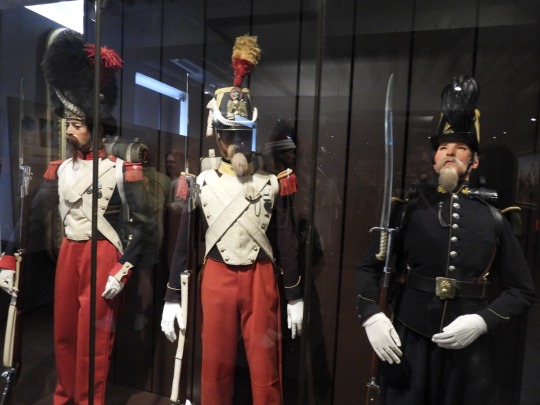
The arms and armour wing, which covers the 13th through to the 17th Century, isn’t quite my thing (except, of course, for the 17th Century stuff, as I’m a bit of a closet English Civil War buff.) That said, the armour collection in there is very impressive, and I can see a medievalist having a whale of a time in it. There’s even some Japanese and Chinese stuff - although maybe we shouldn’t think too hard about how the French got these treasures.
The World Wars section was good, but not good as I remember it being in my last visit several years ago - perhaps its a case of rose-tinted memory. Still, there’s a lot of very interesting stuff in there - particularly French stuff, which really shouldn’t be surprising. One thing that amused me was the wing’s total refusal to show British kit unless they absolutely had to - there are three cabinets which contain any British uniforms in the First World War section, one of which is dedicated to the war in the Middle East generally, and one of which is mostly about the Dominions. The WWII section is even better - the only place they show much British objects is in the Normandy section, where they wouldn’t have been able to get away with excluding them. The French Army is credited as being the sole - not one of, the sole - reason that Dunkirk worked.
You might ask why I’m complaining about the lack of British representation in the French Army. First of all, I’m not, I think this is hilarious. It just sticks out when the French have big parts of the museum dedicated to the Eastern and Pacific Fronts, fronts which mostly neither concerned France or had many Frenchmen in them, and are happy to include lots of American objects, but go out of their way to exclude Britain as much as humanly possible. Basically, it’s the story of how the great allied powers won the war - the US, the USSR and France, with a tiny participation by les fuckuers who abandoned them at Dunkirk. Never change, France, never change.
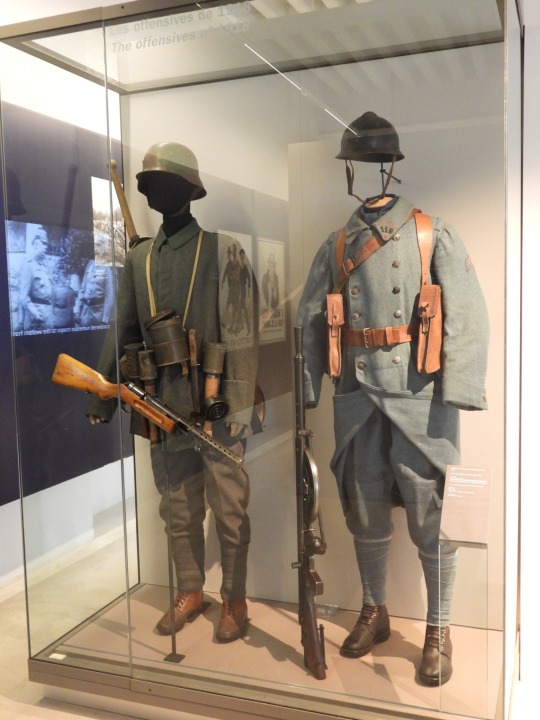
After the Sir John Monash Centre, I really don’t have any right to be cross. Everyone does this - we do, the French do, the Turks do, the Yanks certainly do. We all play ourselves up, in war, politics, society and sports - just look at the cricket, where it’s okay when Australia cheats but if England cheats we need to go to war (and vice versa, of course.) We should strive to tell history as accurately as possible, free from the blinkers of nationalism - as they try to do at Ypres and Peronne and even the IWM - but we can’t really be surprised at museums that don’t.
I emerged from the gift shop next to Napoleon’s Tomb, but as I approached, I discovered that I’d managed to lose my ticket - I’m still not quite sure how, but I think it might have slipped out of my bag while I was getting my wallet out to buy a magnet. For a moment, I was frustrated - but then I thought about it. I’ve seen enough dead people, enough cemeteries, enough tombs. Who is Napoleon Boneparte but another man? Why is he so important that I must pay to visit him - heck, I don’t even respect him! Strip away the pretence - the First Consul, l’Emporeur, the Conquerer - and he’s no better than you or I. When one has seen those graveyards full of indispensible man, a monument to a conqueror seems rather trite.
So I left, walking out of Les Invalides through spitting rain, past the cannon and the mortars towards the Metro, bound back to my hotel to ruminate on more peaceful matters.

The End
3 notes
·
View notes
Text
4 July 2023
These Green Fields of France
Paris
4 July 2023
On the 1st of July 1916, a thousand tragedies played out in a thousand places. It seems monstrous to classify them as ‘better’ or ‘worse’ than any other, but perhaps one of the saddest stories of the entire war happened at Beaumont Hamel, a short distance from Thiepval and Pozieres. It was here that the 29th Division, fresh from the horrors of Gallipoli, attacked. Among them were the Royal Newfoundland Regiment.
In the early 20th Century, the modern Canadian provinces of Newfoundland and Labrador were their own nation - the Dominion of Newfoundland. Their population was small, but they managed to raise a battalion - the so-called ‘Blue Puttees’ - to fight in France. They’d diverted to Suvla Bay on the way, but now the 780 active officers and men had reached the Somme, ready to take part in Britain’s largest push of the war. These men did not consider themselves Canadian - they were Newfoundlanders and proud of it, and likely had more bond with the British of the 29th, who had shared the experience of Gallipoli, than their neighbours in the CEF.
That July morning, the 29th’s attack, like most divisions on the northern and central parts of the Somme front, was meeting with disaster. The 86th and 87th Brigades were bogged down before the German wire, and the GOC, Major-General De Lisle, had no way of knowing precisely what was becoming of his men. Reports came in that British troops had apparently broken through - if so, they needed support. De Lisle committed the 88th Brigade, the Newfoundlanders amongst them.
The British trenches were so clogged with the dead and wounded that the regiment was forced to go over the top from a support trench 250m behind the British front line. As they emerged, they were suddenly the only moving troops visible to the Germans - all of the enemy’s fire fell upon them. Ahead in No Man’s Land was the ‘Danger Tree,’ a skeletal husk that was meant to be used as a way point, towards which the Blue Puttees now headed. Unfortunately, the Danger Tree was known to the Germans, who had the area presited for artillery.
As far as I’m aware, none of the Newfoundlanders made it anywhere near the German line. It was the Nek played out in France, but drawn out and - incredibly - even worse. Of the 22 officers and 758 men of the Blue Puttees that set out that day, only 68 were present at roll call the next day. When General De Lisle reviewed the situation, he made a poignant, perhaps even somewhat self-critical, remark - “It was a magnificent display of trained and disciplined valour, and its assault only failed of success because dead men can advance no further.” Only one battalion - the 10th West Yorkshires - suffered worse casualties.
Newfoundland never recovered. The high casualties, combined with the Great Depression and political scandals, led to the revokation of responsible government in the 1930s and the absorption of Newfoundland into Canada in 1949. 1st July, for most Canadians, is Canada Day, but for the people of Newfoundland and Labrador, it remains a day of mourning. It’s a graphic reminder of how war can destroy not only men’s lives and bodies, but the hopes and dreams of whole peoples.

We left Amiens at 8.30 for our last battlefield tour - it feels like years since we first scaled Plugge’s Plateau. Our first stop was the Querrie British Cemetery. I had reached the point by then where I felt entirely numb to cemeteries; even the most intimate of epitaphs failed to get through an emotional weariness created by seeing grave after grave after grave. I was hit a little by one discovery - in this cemetery for the men of the war to end all wars, there’s a British pilot shot down during the Battle of France in 1940. But even then, that was a moment of pause rather than an emotion - a brief moment to say ‘huh’ rather then anything deep and moving. I thought there was no more the Western Front could give me.
Next we went to Pozieres Windmill (after swinging past Albert for photos of the famous tower), which I’ve visited before. I still like the area - the memorial to the Tank Corps is across the road, so I stopped to look at that before following the group to the Windmill. The first thing you’ll notice about the Windmill is the lack of a windmill - there was one, once, but it was blasted apart by artillery during the ferocious battles on 1916. This is the place that Charles Bean described as being ‘more densely sown with Australian blood than any other place on Earth.’ In six weeks, as many Australians died as during the whole Gallipoli campaign.

When I last came here, there was a field of little hand-made crosses dotting the field beyond the craters. You could walk straight out there and stand amongst them - and to the WWI Animals Memorial, which is behind the Windmill. No more. A hedge blocks the way now, as if the Animals Memorial is too vulgar to share space with the Windmill site, and the crosses have been cleared away. Instead there’s a Hollywood Sign styled collection of words dominating the view from the tallest crater, screeching ‘POZIERES 1916 LEST WE FORGET’ at the viewer, and beyond that a carefully manicured bed of roses. I know not who did this, but it feels like the initiative of a Big Man - the Mayor, perhaps, or the DVA - thrusting aside the small, thoughtful memorials of the peasantry to make his own statement. So often this seems to be the case - be it Howard and Abbott’s hundred million dollar baby under the graves at Villers-Bretonneux, or the carefully choreographed dawn services at Anzac that replaces the small ones at the Beach Cemetaries. Memorial culture is dotted with Big Men with Big Ideas and Big Egos, and I think the world would be a better place if they left things well enough alone.

The caretakers of the battlefield at Beaumont Hamel did precisely that.
There were three artificial things I found at Beaumont Hamel, excluding the footpaths that allowed the visitor to navigate the site. The first was a small museum, basically built in a cabin that sits out of the way. The second is the big caribou monument built in the 1920s, the giant animal facing into No Man’s Land as if calling the souls of the dead home. Finally, there’s a modest replica of the Danger Tree installed to give visitors an idea of where it was. Otherwise, the battlefield, bought by the Newfoundland government and now owned by the Canadians, is left as it was for nature to reclaim. The shell holes and trenches remain, but they’re covered in grass now, and there’s patches of forest and trees. The Beaumont Hamel battlefield has returned to the Earth from whence it came, and I found that my capacity to care had not been exhausted after all.
Standing next to the site of the Danger Tree, staring out into No Man’s Land, thinking of the futile deaths of hundreds of men, and hearing the distant sound of birdsong and feeling the warm sun, I felt the urge to shout out at the sheer folly of it all, to forcibly drag the group, who I felt weren’t appreciating the site possible, to the cemetery beyond to read the names. How could you stand here and not feel? How could you still talk and laugh and joke about small nothings in a place like this?
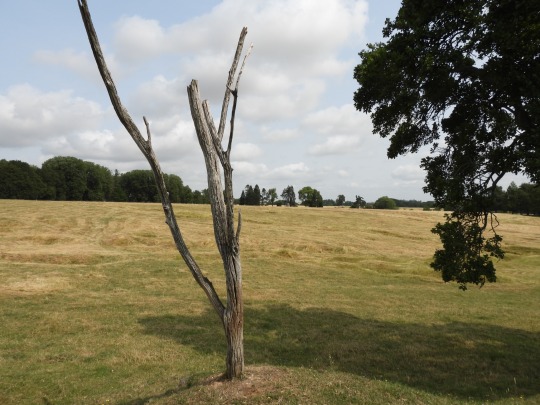
But then I talked to Maddi, and she gave me a different perspective. Of course they laugh and joke. That’s how they process going to cemetery after cemetery after cemetery. People react to confronting sites differently, and just because I might think someone’s being disrespectful doesn’t mean they are - or at least not intentionally. I think they laugh and joke about things happening in the world today for the same reason I started to go numb - because if you focused on all the grief and loss we’ve seen this past few weeks, if you made yourself feel every bit of it, you’d go mad. And did I not laugh at the Sir John Monash Centre, sitting as I was under the graves? Who am I to criticise them? Did not the soldiers I was thinking about use black humour to cope with their situations?
People are strange, and I sometimes have trouble really understanding them. I think every does, but some are better at hiding their puzzlement at humanity.

We stopped at Ulster Tower to eat in their cafe, but they weren’t serving food so we cut our losses and ate at a service station near Albert. We then went back out to Thiepval.
The Thiepval Memorial was once described as a structure consisting of ‘deranged arches,’ and that critique isn’t entirely wrong, but I’ve always found it strangely beautiful - more so than the more famous Menin Gate. This discordant memorial, situated in the middle of the most beautiful part of northern France, lists the names of the missing of the Somme; British and French. I don’t know what the group discussed here, because I walked up the steps alone. I found a name for a family member, then stepped up to stand under the central arch, where the stone reading ‘their name liveth forever more’ resides. From here, you can see the cemetery - French to the left, British to the right, the Cross of Sacrifice between them.
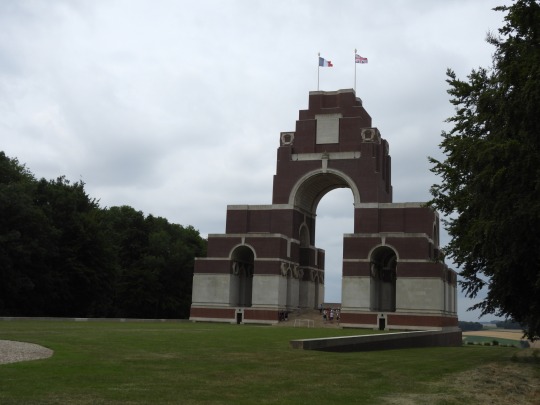
I walked down there. Normally I’d walk among the graves, looking for interesting epitaphs, but this time I just sat down in front of the unknown soldiers and, as Eric Bogle’s famous song goes, sat for a while ‘neath the warm summer sun. Just me and him, whoever he was.
There is no such thing as a necessary war - even when you’re fighting to defend yourself or someone else, you’re doing so because somebody attacked you. There is no glory, and fundamentally no point, in trying to achieve political goals through military might. All those great ‘heroes’ of conquest - Alexander, Caesar, Napoleon - I find them contemptous. War is young men - kids, even - dying for old men. It is violent, it is grotesque, and any statesman who would consider it anything more than an absolute last resort isn’t worth their salt.
There’s heroism in war, I will say that - the fighter pilots of the Battle of Britain, the Allied troops who stormed Normandy, the stretcher bearers who risked life and limb to save others. Mostly it’s just killing and dying. I can’t look at the Newfoundlanders, or the men at the Nek, or Bullecourt, or Chemin des Dames or Passchendaele or a thousand other stories of military failure across history - and say they ‘sacrificed’ for us. They died for nothing. They didn’t shorten the war by a single second. They didn’t die for our freedom. The only way we can make these deaths mean something - anything at all - is to endeavour never to let waste like this happen again. To research their histories, to tell their stories, to reveal everything warts and all, and hope and pray that the lesson will stick.
Maybe one day we’ll learn.

We’re in Paris now - our last teaching exercise is tomorrow. I’m filled with a sense of melancholy, but at the same time relief. I think I’m about ready to step out of the front line.
3 notes
·
View notes
Text
3 July 2023
Oh It’s A Lovely War
Amiens
3 July 2023
By the end of 1917, time was running out for Germany. Russia may have sued for peace, but the United States had entered the war, and Generals Hindenburg and Ludendorff, now effectively dictators of Germany, knew that numbers would soon inexorably favour the Allies on the Western Front. Ludendorff needed one last masterstroke - a decisive battle to destroy the French and British before the Americans could arrive.
The great offensive - Operation Michael - was aimed at Gough’s Fifth Army, still exhausted from the hell of Passchendaele. On the 21st of March 1918, after a sudden and violent artillery and gas attack, German stormtroopers smashed into the Fifth Army, and although their losses were massive, they attacked with such force that Fifth Army gave way. For a moment, as Haig scrambled to plug the gaps in his line and Fifth Army’s command and control disintergrated, it looked Germany might actually win the war.
It is here, in the popular narrative, that Australia stops them at Villers-Bretonnaux. In reality, there were two battles here that sometimes get conflated into one. At First Villers-Bretonnaux, British and Australian troops managed to halt the German offensive just short of the town. This wasn’t the only place where the BEF had managed to blunt Micheal - Arras held, and while the Germans had taken Albert, they had advanced little further. It was however the final nail in the coffin for any German effort to take the vital railway hub at Amiens. The Germans made a second attempt on the 24th of April and briefly captured the town, but were repulsed by a counterattack the following day. The popular idea here is Chunuk Bair in reverse - the British ‘lost’ the town and the Australians ‘retook’ it. In fact it wasn’t so simple - two Australian and one British brigade took part in the counterattack, alongside French Moroccan troops to the south.
It was a significant victory, but it didn’t stop the Germans completely. Ludendorff launched more offensives throughout the spring (including towards Hazebrouck, which was defended by First Australian Division and several British divisions.) Against all of them, the Allies held, although the fighting was hard and the cost was appalling. The cracks in the German strategy began to show - more and more American troops were being moved in front of them, and more and more of their best men were being killed. The end of the Spring Offensives came at the Second Battle of the Marne, in which chiefly French but also British, Italian and (for the first time in significant numbers) American troops decisively stopped Ludendorff’s last throw of the dice. No one country can claim credit for this - stopping the Spring Offensives required the full effort of every major participant in the Allied order of battle. It was a team effort.
Some people don’t seem to understand that, and sadly they’re often the people in charge of commemorating the war. Which brings us back to Villers-Bretonnuex.

Our first stop today was Adelaide Cemetery, just outside the town. If the name seems familiar, it’s because I’ve mentioned it before, although it seems like years ago now; this was where the Unknown Soldier was exhumed. Today, his former spot is marked with a special inscription, but otherwise the plot has the same shape of tombstone as everybody else. One might lament that he’s been removed from a peaceful plot in France to the hustle and bustle of Canberra - if, of course, they didn’t know that Adelaide Cemetery is sandwiched between a major road and a railway line, so he probably would find the AWM more peaceful.
We went from there to the Australian Memorial outside Villers-Bretonneux. John Monash Centre aside - and I swear, we’ll get to that soon - this is beautiful site, nestled amongst rolling hills and endless fields of wheat. To get to the main monument, you pass between two cemetery plots, as if the graves are lined up on parade - these are largely Australians, but there’s also a lot of Canadian and British soldiers who lost their lives in the battles around Amiens in mid-1918. You pass through two flag poles - French and Australian - and reach the main facade, in which the names of Australia’s missing in this sector of the front are carved. In the middle is a tower - it still bears the scars of the war that followed the war to end all wars.

Visitors can climb the tower, where they can get a commanding view of the countryside. You can see the town itself, and the distant shapes of other strategic features - for example Le Hamel, which we’ll talk about at the end of this log entry. Even if you’re not interested in military minutia, the view is amazing.
It was as we left the tower that one of the most curious and strangely moving episodes of this tour occurred. As I walked down the front steps, I saw a man with a bugle in British service dress - the uniform of the British Tommy - and an officer trudging up to our position. Somehow, in the middle of France, I had encountered some reenactors. It turned out there were seven of them - three men in Welsh Guards uniforms, a Highlander, a nurse, and two members of the Royal British Legion. They’d been deputised by an Australian family to pay tribute to one of their members lost in France during the war.
Suddenly, we were conscripted into this odd little ceremony. We gathered around - the bugler sounded the Last Post, there was a minute’s silence, and then two of us left a wreath in the tower as the Highlander played his bagpipes. It ought to have been very silly, this memorial service with these men in old uniforms, recorded on an iPhone for a faraway family. And yet I teared up. I don’t know why this got me, but I think part of it is the spontaneous nature of the event. These guys were from Wales and England. They had no obligation to pay one of our men this heed - and yet they did, and they went to such effort to do it. We even sang the national anthem together - I can’t remember the last time I actually sang it.
We interrogate forms of remembrance a lot on this course - it’s kind of the point - and we did have a little discussion of this a bit later. Sometimes I feel we as historians can be a little too cynical about this sort of thing. I don’t know if crossgeneration or surrogate grief is something that can be quanitified, but it was real for them, and I think that’s what really mattered.

And then we went into the Sir John Monash Centre. And oooooooh boy.
Remember how I said the museum at Peronne didn’t meet my expectations? Well, this exceeded my expectations, and it did so triumphantly. I expected that this would be bad, but what I got was a nearly heroic example of utter shitness. It crosses the line into utter inappropriateness, speeds right across the world like the Flash, and crosses the line a second time. I’m almost impressed.
First of all, everything - everything - is digitally integrated. You actually have to install an app onto your phone andhave headphones plugged in (or rent them for three euros) to understand anything that goes on here. You then walk up to screens - it’s almost entirely screens, like a sale at Harvey Norman - and press the number of the screen - except if its already playing, the recording just picks up where it already was, which is often halfway through the video. If the screen is out of order, well, no content for you. The inevitable question, of course, is how would you interact with this if you were blind, or deaf? I guess being deaf is just un-Australian.
And the content? I will be fair here and say nothing is technically incorrect, or at least nothing I was actually able to view and hear. My problem is more about what the museum doesn’t say. Monash’s somewhat indifferent career commanding 4th Brigade is neatly glossed over. So too is the Hindenburg Line battle of 29 September, and don’t worry, we’ll get to that. Every other combatant in the war is a footnote, which gives the impression that Monash and the Australians are personally winning every major battle of 1918. Then there’s the language - Australian units withdraw, while British units are shattered. All this is underlined with dodgy, overacted dramatisations and a tactical war that uses 3D models to showcase the battles of Fromelles, Polygon Wood, Amiens and St. Quentin - all rather badly posed, and all looking like they came out of a pre-alpha version of Battlefield 1.
Then there’s the experience. The experience is what this whole thing is built around - the brilliant idea to have a light and sound show right beneath the graves of the dead, giving the visitor a feel - as if that’s possible - of what the Villers-Bretonneux and Hamel battles were like. I actually managed to get a session where I was the only oneside when it started (the door shuts while it’s playing.) I am truly thankful I was. When the government commissioned historians to plan this, they outright said that they wanted visitors to feel ‘pride with a touch of sadness.’ It would probably be difficult for audiences to feel such emotions if they were sharing a room with a university student pissing himself laughing.
Yes, this is conceptually appalling to me - but it’s also so silly that I couldn’t help but laugh, and laugh hysterically at some points. After opening with British troops fleeing Operation Micheal, literally screaming and crying - I’m surprised the director showed enough restraint to stop himself from staining all their trousers with wet patches - a sinister German voice who’s probably meant to be Hindenburg but sounds more like Major Toht from Indiana Jones declares his intention to destroy the British. The viewer is ‘gassed,’ which feels more like sitting in a smoking room at Hong Kong Airport. Then come the brave, steely-faced Australians, counter-attacking alone into Villers-Bretonneux. They get into the Beastly Hun with their bayonets. Some die and it is Sad. One kicks in a door and hip-fires his Lewis Gun into three Germans Rambo-style whilst going “AAAAAAAAAAA” - and then I don’t know what happened for the next ten seconds because that scene was so ridiculous I started cry-laughing.
Then we move onto Hamel, and here comes the great hero, Monash. He points at maps. He walks next to tanks. He stares heroically into the distance. There are no other generals, or even other officers - there is only Monash. (I could almost feel the ghost of Pompey Elliot swearing up a storm next to me.) Monash unleashes his vague powers of tactics upon the Beastly Hun, and the Australians go in. The Germans all have gas masks and therefore have no faces, making it okay to kill them. The sound of artillery forms the drum beat of a Hans Zimmer style musical track as the battle goes on. There’s tanks. There’s explosions. There’s strobe lights. There’s another bloke hipfiring a Lewis Gun and going “AAAAAAAAA.” There are no Americans. Americans don’t exist. And then, because the director suddenly realised that this is meant to be a site of commemorative diplomacy, a brave Australian soldier waves a French flag. Monash has won the war.
If I tried to come up with a satirical depiction of Australian history, I honestly couldn’t beat this. It is sublime in its idiocy. I want this on DVD. I want to show all my family and friends. This might be the best First World War comedy since Blackadder.
Don’t get me wrong, I think this is very offensive and it shouldn’t be anywhere near a cemetery, let alone under it. But at some point, you just have to laugh.
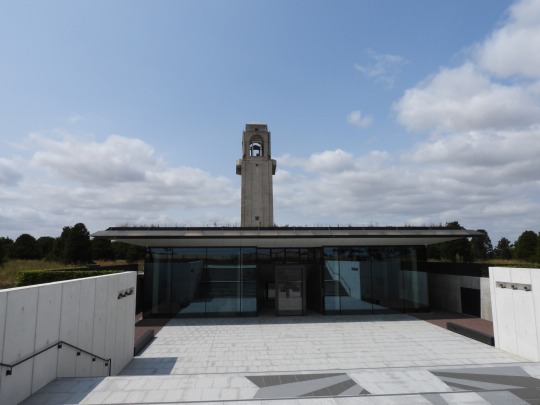
Now there’s one big problem with the Centre, apart from everything else, and that’s the name. John Monash fought a lot of key battles in the Australian Corps’ history. Villers-Bretonneux was not one of them. I do wonder if there was another option here, to focus not on Monash but on Harold ‘Pompey’ Elliot, a superb brigadier who was haunted by his experiences of the war, and whose life was tragically cut short by the consequences of PTSD. At very least, he was actually there and played an important part in the battle.
The Sir John Monash Centre is not the best museum in France - in fact, it’s not even the best Australian war museum in Villers-Bretonneux. That laurel belongs to the French-Australian Museum in the town itself, which we visited afterwards. This is in the top story of the local school, which was rebuilt after the war with subscription money raised by Victorian schoolchildren. To this day, there’s a sign above their courtyard - ‘DO NOT FORGET AUSTRALIA.’ The museum is very small and very intimate, although perhaps a little scattered - it’s clearly a labour of love, a collection of a few treasured relics, models and artworks that connect this small French town with a country on the far side of the world. The assembly hall, which the staff kindly let us go into, is decorated by wooden carvings of Australian animals made by a disabled Australian veteran after the war. This probably cost a fraction of the Sir John Monash Centre, and is probably maintained by two staffmembers and a goat, but it is worth infinitely more than that supposedly ‘world-class’ installation.

Sadly, this museum doesn’t get many visitors anymore - all the tour groups want to go to the glitzy new thing down the road. So here’s my advice - go to the Australian Memorial by all means, but skip the Centre, unless you want a quick laugh. Come here instead. You won’t regret it.
The main teaching for today ended at Heath Cemetery, where we discussed some Aboriginal soldiers’ graves that we’d actually found out about at the aforementioned museum. It’s hard to find Indigenous soldiers - as Aboriginal people were banned from the armed forces, those that passed as white were hardly going to write what they were on their enlistment forms. It’s led to a significant part of the AIF’s history being obscured - but today, it’s being reclaimed as families find their veteran ancestors, dead or alive. In fact, one of the few things I liked about the Centre was an art installation of two emus made from (imitation) barbed wire - a symbol of these men who died so far from Country under an unfamiliar sky, with no Southern Cross to guide them home.

We headed back to Amiens, and most of the group alighted here, but a few of us - the cool members of the group - went back out to the memorial at Le Hamel. This is a curious memorial, but I don’t hate it - it’s basically a big slab in the middle of a wheatfield with the Australian, American, British, French and Canadian flags flying above it. (This is where the Red Baron was shot down, and as the Canadians still think they got him, they get to have a flag.) Plaques on the path to the memorial describe the course of the battle fairly well (although I feel they do a bit of an injustice to the Tank Corps, which are never mentioned by name.) Once there, you have a pretty good picture of the fields leading to Le Hamel, the town that Monash famously captured in ninety-three minutes on the 4th of July 1918.
Hamel was a great achievement, but it needs to be put into context - this was a local action in preparation for the real offensive at Amiens in August. Here Monash also performed very well, but so too did Currie and the Canadian Corps, and Sir Henry Rawlinson in overall command. (The British III Corps advance was less impressive, but still outstanding by Western Front standards.) Between Hamel, Amiens and Mont St. Quentin, Monash more than earned his reputation as an outstanding commander. But he wasn’t infallible, and now I can finally talk about 29th September 1918 and the St. Quentin Canal.

Monash and the Australian Corps were meant to be the main force here. IX Corps (remember them from Suvla?) were to swing south in a secondary role, while III Corps, whose commander had just been sacked, was mostly left out. By this time, Australian Prime Minister Billy Hughes was insistent that the Australian divisions be taken out of the line for a rest, and this had already happened with the 1st and 4th Divisions. Monash and Rawlinson had managed to hold onto the 2nd, 3rd and 5th Divisions for this final action against the Hindenburg Line, but had had to replace the other two with the 27th and 30th US Divisions. These troops were nowhere near as experienced as the men they’d replaced, but Monash’s plan doesn’t seem to have accounted for that, and he used a strategy he’d used to great effect at Amiens - send two divisions in first, then leapfrog them with fresh divisions once the first wave had taken their objectives.
The Americans performed about as well as could be expected, and their bravery was in no doubt, but they didn’t know how to properly clear out the German trenches that they were advancing over. Inevitably, when the Australians came in, they ran into German strongpoints that had been temporarily suppressed, but not destroyed. This resulted in heavy casualties and bogged down the advance. A frustrated Monash took days to pound through, and with the benefit of hindsight, he really should have altered his plan to account for the greener troops - instead, he and Rawlinson, somewhat unfairly, blamed them.
All this was probably academic, because while the Australian Corps was pounding along, the Hindenburg Line had already been broken. Remember how I said that I didn’t think Mont St. Quentin was the greatest military achievement of the war? I define military achivement differently to Rawlinson. Taking a position against all odds is definitely impressive, but carrying out an operation so effectively that your troops don’t really need heroic daring do is quite another, and this was what happened on the IX Corps front in the south. The 46th Division at Bellenglise - as standard and normal a division as any - had swept across the St. Quentin Canal in perfect concert with their artillery, capturing an intact bridge and the village. For the loss of 800 casualties they captured over 4000 men, and tore a gaping hole in the Hindenburg Line that the following 32nd Division was able to exploit. This, in my opinion, was the outstanding military feat of the First World War - because so much was gained for such (by Western Front standards) a cheap cost. Rawlinson rightly shifted the main axis of his advance south to support it, and after a few more days of hard fighting, the Australian Corps was finally taken off the line for a well deserved rest. The war would end before it could return.
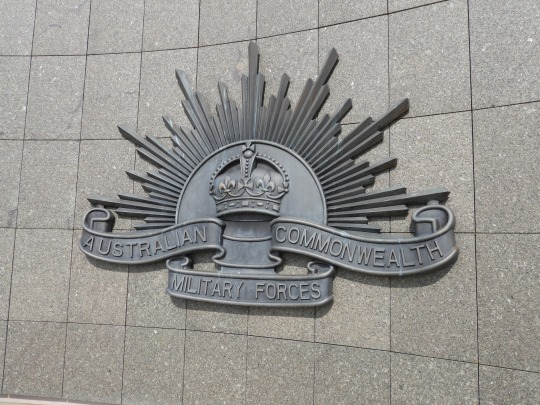
Well, that was a digression and a half. Tomorrow we leave Amiens, heading down into the Somme for the last big day of battlefield touring, and then onwards to the City of Lights itself.
Oh, one last story before I forget - our professor dug this up while looking through Monash’s correspondence for a history of Melbourne’s Shrine of Remembrance. Towards the end of Monash’s life, he began to think of what he ought to leave for Australia. As a war hero, he thought, he needed to leave them an example to look up to. As he was making arrangements for his legacy, he noted particular papers that he needed dealt with properly, as a matter of national importance.
So, shortly after he died, someone gathered these papers - I think his executor. As John Monash was buried in his modest grave, marked only with his name and eschewing his many honours, this person took them somewhere safe - perhaps an incinerator, or a bonfire in the bush. I can imagine this person, a tear in his eyes, a bugler playing the last post, as he was forced to consign a major piece of Australian history to the flame.
But duty called, and this man would obey. And therefore, with a heavy heart, he destroyed General Sir John Monash’s enormous collection of pornography.
4 notes
·
View notes
Text
2 July 2023
The Death Drill
Amiens
2 July 2023
We must return again to the Hindenberg Line.
I mentioned earlier that the Hindenberg Line was eventually cracked. We’re still not there yet - that’ll be a discussion for tomorrow. I have, in fact, been very deliberate in waiting for that moment. As I mentioned on the 28th, the Hindenburg Line was a perfect defensive position, and one that the Allies encountered with some surprise during the Arras offensive. It did not blunt British ambitions - it simply couldn’t be allowed to. To the south, on the Chemin des Dames, General Robert Nivelle’s French offensive was drowning in blood, and Haig had to try and keep the pressure off of them. The Line would have to be attacked. Thus, the tragedy of Bullecourt.
Bullecourt - and given the black humour of the Tommies and the Diggers, I’m surprised it was never corrupted into ‘Bullet Court’ - was to be attacked by Hubert Gough’s Fifth Army in a novel way. There would be no preparatory barrage. The 4th Australian Division would attack by surprise with the support of tanks. In the event, when the attack was launched on the 11th of April 1917, barely any tanks arrived - they almost all broken down, and the few lumbering beasts that made it to the starting point were soon knocked out. Worse, the loud engines alerted the Germans. The Australians advanced into a funnel, covered on all sides by interlocking fire - some positions were taken but then lost by a fierce German counterattack. Three thousand men became casualties, and more men were taken prisoner here than in any other Australian battle. To add one final insult to injury, Gough, convincing himself that he had an exploitable breakthrough, sent an Indian cavalry brigade into the killing field, causing yet more useless deaths.
Something changed in the AIF after First Bullecourt. Gough’s reputation with them never recovered (and indeed, he was despised by pretty much everybody who had the misfortune of being under his command), even though some of the blame for the catastrophe should also be laid at the feet of Birdwood and some of the battalion and brigade commanders. The Australians would take a long time to trust tanks again, but in particular, a large part of the AIF lost faith in the old British Army. Most of this loss of faith was directed towards the generals and the staff, but Bill Gammage’s seminal work The Broken Years indicates that a great many men lost their respect for the ordinary Tommy too. The British, it was said, had let them down; they had no stomach, they couldn’t fight, they’d left the Australians in the lurch. (In fact, poor staff work had led the British 62nd Division to attack too early, with predictably bloody results.) I remember reading Gammage’s book a while ago, and some of the accounts felt like a few Diggers would have rather dug their bayonet into a British Tommy than a German soldier. Always be suspicious when you hear people talking about the brotherhood between allies.
(The British stereotype of the Australians was that they were overpaid and underdisciplined, and that they had everything you could ever want but still moaned about it, so lets not pretend this doesn’t go both ways.)

That tragic field of Bullecourt was our first stop of the day. None of the Australian divisions chose here to be their memorial, for reasons that are probably obvious, but a memorial was put in place to the battle in the 1990s. It depicts a Digger on a cairn, starting out towards the battlefront and the site of the Hindenburg Line. He looks almost casual, wearing his slouch hat with his rifle slung over his shoulder - yet there’s a somber weariness to his features. I don’t think there was any deep meaning to this figure when it was sculptured - more likely the DVA just said ‘STATUE PLEASE’ - so it’s interesting how the mind invents them when looking at statues like this.
We carried on from Bullecourt to Peronne, where the memorial to the 2nd Division stands on the slopes of Mont St. Quentin. It was here that the 2nd Division seized the heights from the Germans and held it in the face of several ferocious counterattacks, an achievement Fourth Army General Sir Henry Rawlinson believed was the ‘greatest military achievement of the war.’ (I actually disagree with Rawlinson on this, but that’s another thing to be discussed tomorrow.) The 2nd Division’s memorial is actually a replacement - the original might have been the most ‘metal’ of Australia’s war memorials, depiciting a soldier thrusting his bayonet into a Prussian eagle. When the Nazis came through in 1940, they spared most other war memorials - but they destroyed this one. It was replaced in the 1970s with a soldier looking down in thought. It’d diplomatic, and probably more appropriate - but I’d be lying if I said I didn’t have a sneaky desire to see the old one.
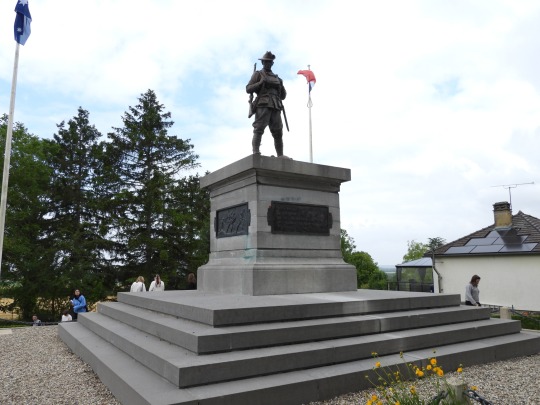
We continued into Peronne, and after lunch went into the Historiale de la Grand Guerre - the Museum of the Great War. This has been built up for me for years, the brainchild of Annette Becker and our spiritual liege Jay Winter. They are, of course, no longer with the museum as far as I know. I think this may be to it’s detriment, because the main feeling I felt here was a sense of disappointment.
This museum is still worth visiting, and I don’t know if it would ever have lived up to my expectations. Laying the uniforms and equipment at the viewer’s feet, as if laying in state, is not only artistically genius but surprisingly practical in allowing you to actually see what these artifacts are. There’s a whole section on the work of Otto Dix, a soldier who made print art of his experiences after the war. I won’t include any photos of these pictures, because while Dix’ works are amazing and everyone should see them, they are also, pardon my French, fucking horrifying.(The Nazis, being big on the whole war as national regeneration thing, banned them.) It does its best to cover as many perspectives on the war as possible, and while the pacifist bent here is obvious, it doesn’t get in the way of being a museum too much.

That’s a bit of a shame, though, because it’s the ‘being a museum’ category that causes it to fall down for me. There are so many errors that somebody really ought to have caught - a tunic of the Leicestershire Regiment is mislabelled as a Coldstream Guards tunic, which would be forgivable were it not for the giant ‘Leicestershire’ badges on the collar, clearly visible to the public. A tunic is described as belonging to a ‘Captain’ in the ‘Derbyshires’ - not only does it belong to a Lieutenant, there was no Derbyshire Regiment. That region was covered by the Sherwood Foresters. I’m sure this all sounds like rivet counting, but these are errors that are easily noticeable and easily corrected, and they’re in the first room. If they’re making basic factual errors in the first section of the museum, why should I, as a member of the public, trust what they say in the next? (And before someone asks if they simply mistranslated the name of the rank, lieutenant is a French word. The word for lieutenant in French is lieutenant. I don’t know how a museum of war could make this mistake.)
This annoyed me, but what got me really cross was a placard about the Hundred Days Offensives at the end of the war.
‘Without suffering any great defeat, the German Army was forced…’
Hold on, what?! Not only did the German Army suffer a great defeat, it suffered nothing but great defeats. What about Second Marne? Amiens? The St Quentin Canal, the Canal du Nord, the Meuse-Argonne Offensive? The Germans were defeated decisively and consistently on the field of battle, and I know a museum with a pacifist bent probably doesn’t want to throw around words like ‘victory’ in relation to war, when it comes to the Hundred Days, you have two choices. You have the history or the myth. The history was that Germany was decisively defeated. The myth was that it wasn’t. The myth is that the war was ended by the civilians - the socialists - while Germany was still capable of fighting. The myth is that Germany was betrayed by the socialists - and their perceived masters.
This is the genesis of the stab-in-the-back theory, one of the first steps on the road to the Holocaust. I know they didn’t intend for it to look like this, but that is what it looks like. You don’t have to necessarily say the Allies won, but you absolutely do have to say the Germans lost, and lost decisively. We cannot allow any academic or popular wriggle room for this antisemtic theory. (And for the record, I think you absolutely can emphasise this from a pacifist perspective. Talk about the suffering inflicted by the naval blockade, or the casualties of the Hundred Days. Just… don’t repeat antisemitic talking points.)

Sorry, I got a little bit angry there. Let’s talk about something a little more humorous - the cognitive dissonance one experiences when they leave this museum, Dix’ paintings still on their mind, and walk into a gift shop that’s selling faux-LEGO tanks, plastic helmets and poor quality hoodies with little Anzacs and Poilus shaking hands on them. It’s something of a mental whiplash, like I felt when I went into Rise of Skywalker expecting to have fun and then didn’t.
We went from there to Delville Wood, where the South African National Memorial is - a great shock, as I wasn’t aware they had one at all. The South Africans today are most known for fighting in East and Central Africa, particularly the running guerilla war with von Lettow-Vorbeck (in which 80% of their black African labourers got malaria and died.) Yet they did send a few battalions - all white men, of course - to the Western Front, where they suffered greatly in battles around here. The beautiful and sinister at the same time. For the most part, it looks a lot like you’d expect a First World War memorial to look - white stone, lists of the missing, inscriptions of battles - but over the arch in the centre is a message to all visitors - ‘Their ideal is our legacy. Their sacrifice is our inspiration.’

It seems a bit generic, but in the context of the Apatheid South Africa that raised this memorial, it’s downright chilling. What ideal are they talking about? We can’t exactly change the meaning of it - it’s ‘their’ ideal, not ours. For the first time, I found the white wall of the missing, amplified by the afternoon sun, to be deeply uncomfortable.
On a more positive note, the site has a small museum - and it’s free! If the memorial hasn’t been updated since the end of Aparteid, at least the museum has, with a frank discussion of the service and suffering of black South Africans during the First World War alongside the typical histories of battles and kit. What particularly stood out to me was the account of the sinking of the SS Mendi in a collision off the Isle of Wight, carrying black labourers to Europe. Oral tradition preserves the last speech of Reverend Wauchope Dyobha on the deck of the sinking ship. This was reproduced at the museum, and I’ll give you an excerpt.
“Brothers, we are drilling the death drill. I, a Xhosa, say you are my brothers. Swazis, Pondos, Basutos, we die like brothers. We are the sons of Africa. Raise your war cries, brothers, for though they made us leave our assegais in the kraal, our voices are left with our bodies.”
824 labourers were aboard the Mendi. Over 600 were lost to the sea. Reverend Dyobha was among them. They lived as servants of an uncaring empire, but I like to think they died as free men.

We carried on from there to Amiens, where I now have a glorious view of it’s beautiful concrete bus station. I saw a few memorials on my way to grab dinner, and I’ll try to take my camera out to get some pictures tomorrow evening if I have time, but I can’t promise anything. For tomorrow, we go to Villers-Bretennaux.
We’ve seen the tasteful ways Canada and South Africa use the spaces around their memorials. Surely, Australia would be just as tasteful, right?
Right?
3 notes
·
View notes
Text
1 July 2023
Les Canadiens
Lille
1 July 2023
It would be remiss of me, even though we were not in that sector of the front today, not to mention the events that occurred 107 years ago today.
With the French pressured at Verdun, the British Army had been forced to take on the leading role in the Allies long-planned summer offensive. This was one of a series of major attacks agreed upon at an inter-Allied conference at the end of 1915; the Italians will attack (again) along the Isonzo, while the Russians prepare a massive thrust into Galicia. The western attack will fall on a hitherto quiet sector of the line - the region around the Somme River. For five days, one of the heaviest bombardments of the war so far had pounded the German lines. The ‘New Army,’ the name for the tens of thousands of recruits enlisted in 1914, was about to enter its first major engagement on the Western Front (excepting a few battalions used at Loos last September.) The expectation was that the artillery will have smashed the German positions to such an extent that the men could simply walk in to occupy them.
What the Allies didn’t know was that most of the German troops were not in trenches, but in dugouts deep underground, beyond the reach of the shells. After a hellish week under fire, the Germans emerged when the shelling stopped on the morning of 1 July 1916, reoccupying their positions and waiting for an attack they knew was coming.
There were some local successes, but the result along most of the line was catastrophic. Whole battalions were nearly wiped out in the killing fields of No Man’s Land - most infamously the Newfoundlanders and the 10th West Yorkshires, who suffered 90% casualties. Communications trenches were flooded with dead, dying and wounded, forcing reserves to go over from the rear trenches, where they were cut down before they could even leave their lines. Over 58,000 men became casualties, and nearly 20,000 were killed. It remains the worst day in the history of the British Army.
All of this is irrelevant to today’s events as we went to the Arras sector, but I figured it would be wrong not to mention it.

We had a later start today, as some students got the opportunity to discuss internships. We departed the hotel at 9.45 and walked to the Lille War Memorial, where we met our guide for the morning, Annette Becker. She guided us around the city and it’s memorials, including that to the civilians shot by the Germans during the war, the fortress built by Vauban in the late 17th Century, and the memorial to General and President Charles de Gaulle, who was born in Lille. We ended at a memorial to a massive munitions explosion in the 18 Bridges district, which killed about 200 and injured thousands.
This is one of the few times in this tour that we’ve really been able to talk about the role of civilians in war. Lille suffered more than most French cities during the Great War - it was occupied in 1914, and much of the population was deported. Some were shot for refusing to kill their pet carrier pidgeons, as ordered by the German authorities to prevent their use by spies. We were actually told, and I was surprised to hear this, that Lille’s occupation by Imperial Germany was actually worse than its occupation by Nazi Germany, the experience of the Jewish population notwithstanding. (There’s always been a sense of romanticism for the Kaiser’s Germany online. I think it stems from the social unacceptability of admiring the Nazis.)
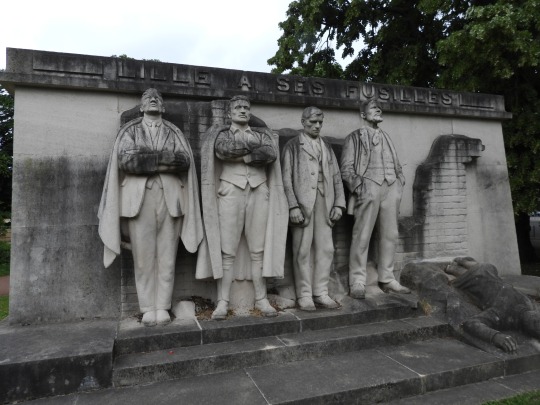
We parted with Annette at midday and drove for Vimy - we didn’t go to Arras, that had to be bumped off because of the internship meetings. This country isn’t terribly pretty, but it’s strategic importance is clear from the landscape - the great slag heaps and chimneys that can be seen for miles around demonstrate that it was and is a nexus of coal and steel production.
Vimy Ridge is the first ridge worthy of being called such I’ve seen since arriving in Western Europe - unlike Passchendaele or Aubers, it’s visible to the naked eye, and indeed is quite a commanding position. It’s here that one can find the towering Canadian National Memorial. It was here that, in April 1917, four divisions of Canadian troops, fighting together for the first time, captured the Vimy Ridge from the Germans, a position that had been considered unassailable. There are some caveats here, of course - the Canadian Corps commander was the British General Sir Julian Byng, and a British division also took part - but it was nevertheless quite the achievement. (Arthur Currie, who is sometimes erroneously called the commander of the Canadian Corps at this time, hadn’t been promoted to that position yet but was in command of the 1st Canadian Division.)

The Canadian Memorial is truly monumental, the pillars towering above it almost forming a ‘V’ shape - V for Victory, Vimy or Valour, I could not tell you. The names of Canada’s missing, save for those on the Menin Gate, are listed around the base, while the names of the CEF’s battles from 1915 to 1918 are etched on the pillars. On the side facing Arras is a crucified man and a grieving woman, and various other figures of valour or grief adorn the structure. At the bottom of the memorial, again facing Arras, is the marble form of a coffin, a discarded sword and a Brodie helmet laid on top - a final funerial touch to what one of my comrades described as a supersized CWGC headstone. I’m not certain of the resemblance myself, but I can see where she was coming from.
About a mile’s walk from the memorial is the information centre. To get there, one has the pass the largely undisturbed site of the battle, pockmarked with craters, old trenches and the occasional chasm created by a mine. These areas are roped off, as unexploded munitions remain in the fields - although farmers allow their sheep to graze there. One hopes they are lightfooted.

The information centre is staffed by Canadian students, one of whom was nice enough to lead us on a tour of the site. The area around the information centre includes a recreated section of trench and a restored tunnel - the Canadians used these tunnels for cover before they advanced on the 9th of April 1917. The tunnel we visited had been expanded and strengthened for visitors, but an unaltered section juts off to the left, giving visitors a view of the conditions in the tunnel on the day of the attack. The trenches are recreated in an artistic way - the sandbags are made of stone, and the trench is shallower and wider than it ought to be - but they give a good impression of a Western Front trench.
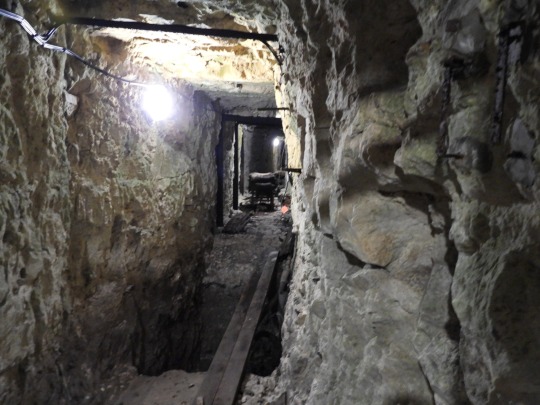
After Vimy, we headed a little way down the road, past WWII memorials to the Poles and Czechs, to Notre-Dame-de-Lorette. This is a concentration cemetery for the French dead of the battles around Arras and Artois, and includes both a graveyard and a church. The scale is prodigious - it reminds us that while the war tore a gaping hole in Australia, Britain and Canada, from France it stole a whole generation. The endless crosses are stark enough, but it was the names of the missing inside the church, etched onto the walls, that caught by breath. They’re etched onto the walls like wallpaper - there are names on every wall in every direction. When you sit in the pews here, you are surrounded by the lost legions of France.
There is a foolish idea that French soldiers are cowards, or are bad at war. I’ve seen all the old jokes - ‘French rifle, never fired, once dropped’ and ‘there are trees on the Champs-Elyesses so that the Germans can march in the shade.’ I urge people who believe this to come here, to see the countless crosses and read the countless names, and then see if they can dare accuse them of cowardice.

A more recent installation at Notre-Dame-de-Lorette is an enormous ring. Here are listed the names of the dead of the Arras and Artois battles. It disregards country and rank, naming every single person in alphabetical order. One walks around the inside the ring and sees name after name after name. When you reach a common surname, you see a wall of Smiths or Schmitts or Singhs, as if they are the bereaved of some massive family. This was a centenary initiative, put into place by pacifists and historians determined to promote peace and to provide equality in death. It is created with the most noble of intentions in mind.
I utterly despise it.
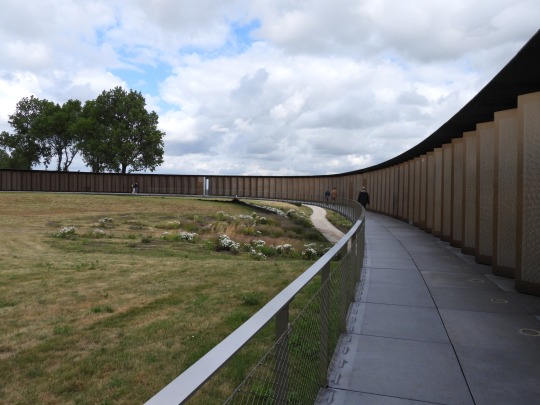
In my mind, this isn’t equality, this is obliteration. This is the annihilation of the human within a faceless mass. At least at the Menin Gate or at Theipval, the men have a sense of community, even if that community is within battalions and regiments. At least they get the basic dignity of being a part of something. I’m sure to the people who made this memorial, the idea of being identified by a cap badge would be horrifying, and I respect that opinion - but those cap badges meant something beyond military administration; they tied them to homes far away. If you were a 1st Battalion man, you were from New South Wales. If you were from the East Lancashires, you probably came from the west of England. You had a community, a history, some form of distinction. Here you are nothing. Remember how I said Langemarck was obscene? So is this, but it’s worse for me, because at least at Langemarck they got to be Germans. These names don’t even really get to be humans.
I’ve read Siegfried Sassoon’s poem on the Menin Gate - those ‘intolerably nameless names’ - but today I think I get it. These people are deprived of all identity, all personality, all story. You may as well as listed episodes of Seinfeld, or types of compost mixture. I know I’m probably going to make my professor very upset by saying this, because I think he really likes it - as is his right, and I think no less of him for it. But this ring is one of the ugliest things I have ever seen. And I think of the money that went into this - we could have spent it on exhuming and digitising records, telling these stories, giving these men life. Is that not a far better memorial? If you want to make a pacifist statement, tell me who these people were, tell the world of these lives cut short. Show us their faces.
Wilfred Owen said these men died ‘as cattle.’ Why should they be remembered as cattle?

We headed back to Lille after that - our last night here. We head on tomorrow, via Bullecourt and the museum at Peronne, to Amiens. Paris, god help us, looms ahead, but there’s still plenty of frontline to get through first.
3 notes
·
View notes
Text
30 June 2023
This Earth
Lille
30 June 2023
In July 1916, as the meatgrinder of the Somme wound on, the British high command looked for methods to divert German troops from that sector of the front. At this stage, the area near Armentières was already soaked in the blood of the BEF - the catastrophic attack at Aubers Ridge on the 9th of May 1915 comes to mind. Now there would be a new attack by Richard Haking’s IX Corps, pushing against the German positions at the town of Fromelles. Two divisions would be involved; the British 61st Division and the newly arrived Australian 5th Division.
Haking’s planning was rushed, and intelligence was poor. Generally, one wants to attack when one outnumbers the enemy by about three to one - at Fromelles, the Australians and British attacked an enemy that outnumbered them two to one. The ground had not been reconnitorered, and the attack required men to advance on a narrow front into German pillboxes and breastworks that covered just about every inch of the flat ground of advance.
The result was an unmitigated military disaster and the elimination of the 5th Division as an effective military unit for a very long time afterwards. The AIF suffered over five thousand casualties and two thousand dead - it remains the bloodiest day in Australian military history.
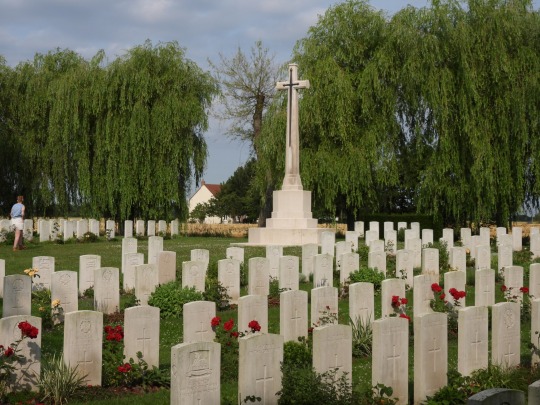
We departed Ypres early this morning and crossed the border into France, arriving at Le Trou Aid Post near Aubers Ridge around 9am. Most of the graves here are British troops killed either in late 1914 or in the disaster of 9th May 1915, but there are scattered names from later battles, including Australians killed at Fromelles. There is one French soldier mixed in with the British, easily identifiable by the French cross headstone, and in the corner what we believed was an unnamed French civilian. Like Essex Farm, Le Trou was an obvious place for a cemetery, being the place where the wounded were carried to be processed or - more often than not - to die.
A little way down the road from Le Trou was VC Corner. This is one of two wholly Australian cemeteries on the Western Front - the other is somewhere in Flanders - and one of the most stark and brutal of the CWGC’s sites. When the dead were exhumed after the war, not a single man could be identified - their bones had become entangled together, with only the shrapnel of their uniforms to tell that they were Australians. It was decided that it would be too much to have a cemetery filled entirely with headstones reading ‘Known Unto God’ - it would be an obscenity - so the men were reburied in two mass graves, covered by flat stone crosses and squares of roses. The names of the missing of Fromelles were engraved at the back of the cemetery, behind the Cross of Sacrifice. There are 410 men here, of 1299 missing altogether.
It was here that I finally got that opportunity to read Wilfred Owen’s Anthem for Doomed Youth that I’d been angling for. I think my professor was a little hesitant to let me, but afterwards he agreed that this was the best place to read it.

Between VC Corner and the modern Digger Memorial is what was No Man’s Land, and few poorer places for a general advance I have ever seen. It is a perfect killing ground - especially in 1916, when the concept of the creeping barrage and combined arms were in their infancy. Many of the bunkers are still there, albeit mostly decrepit - some enterprising farmers preserved trenches and fortifications after the war, knowing they could make a quick franc off of British tourists in the area. The Digger Memorial is a recent installation, erected during the centenary - it depicts an Australian soldier carrying a wounded comrade, and it faces back towards Australian lines. It’s a poignant piece, but it’s a bit of an example of selective memory. In some parts of the line, the Germans allowed this, but in others they used wounded men as bait to draw others into their fire. It all depended on who was in charge and the character of the unit, and I’d be dishonest if I said the Allies never did it too, but the memorial is a conscious choice to focus on remembering compassion rather than killing. This is a good thing, but it’s always good to have a pesky historian around to remind you that war is fundamentally a violent affair.
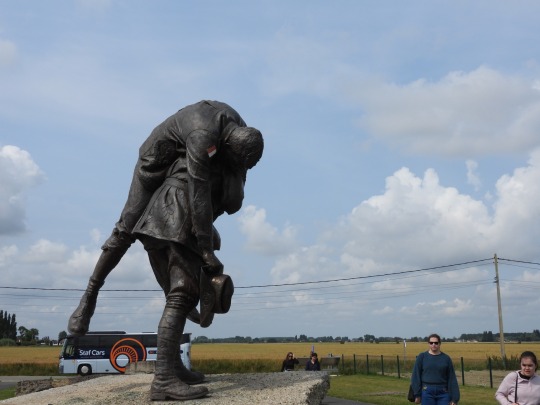
We proceeded from there into Fromelles itself, although we went to the museum just outside the town rather than the town itself (not that Fromelles is particularly large.) The museum is recent, for a reason we’re about to get into, and it’s a fairly small and simple affair. It resembles a lot of French museums I’ve seen - the French love their mannequins, even if some look a little disconcerting. It’s a good primer to the battle, so if you’ve never visited the site I’d recommend it. It ends with the story of the recovery of the dead - not in the early 1920s, but in the early 21st century.
I have met Lambis Englezos, and I want you to understand that I mean this in the most affectionate way possible. Like most people who make history, he’s absolutely insane. In the 2000s, Lambis carried out extensive research and posited that a mass grave existed at Pheasant Wood near Fromelles. He worked this out through a number of primary sources - perhaps most notably, looking at the old German light railway lines behind their front, and aerial photographs from the summer of 1916. His ideas weren’t taken entirely seriously by historians, and there was a hesitancy to dig. It’s hard to blame them - here was this oddball, who didn’t even have a degree never mind a doctorate, proposing to dig up a wood in France to find bodies the Australian government had given up on in 1924. Lambis persisted - in 2007, the government commissioned a geological survey that found out that he could well be right, and in 2008 he was allowed to dig. His team found 250 bodies, mostly Australian but a few British, and for the first time in fifty years, the CWGC was tasked with building them a cemetery.
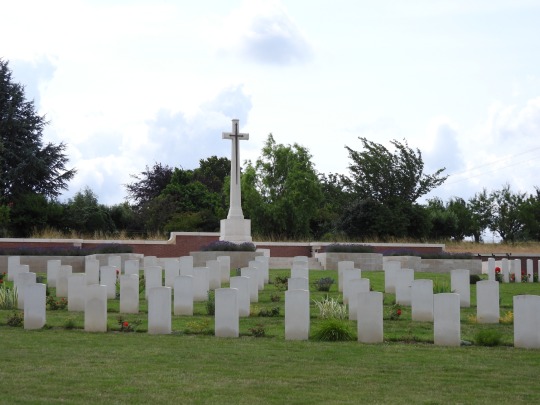
Pheasant Wood Cemetery is the result, and it’s one of the most poignant cemeteries on the Western Front. All other cemeteries record on their epitaphs the words of a lost generation; here, the worlds are ours. There remain the exaltations of sacrifice and giving one’s life for another - and there’s nothing wrong with that, I must add - but among them are reminders of communities, memorials to parents and siblings long past, even nods to how commemoration has evolved since 1918. Wilfred Owen is quoted - even if, thanks to the guidelines of the CWGC, it’s not one of his more condemnatory verses - as is Eric Bogle. Yet for all of this, there’s a sense of disconnection. There’s comfort in calling these deaths sacrifice, in saying they laid their life down for mates or country or king - but from my historian’s perspective, I think this battle was a total waste of human life, not so much a sacrifice but an act of murder by incompetence. Of course, the CWGC would never let you say that on an epitaph, but I think some people found their own ways to get past the censors. One particularly stark one was that of Private J. R. Smith, 31st Battalion. His grave has no cross, just a stark white space between the date of his death and his epitaph.
‘This Earth, his final peace.’
Sometimes the most simple language is the best.

We left Fromelles for Neuve-Chapelle. Neuve-Chapelle was attacked in March 1915 by Canadian, British and Indian troops - it is here that the latter are commemorated. Hindus and Sikhs are cremated after death, and as a result you will not find many in a CWGC cemetery. Instead, their names are listed here - nearly 5000 died on the Western Front. (All in all, at least 74,000 Indians died during ther Great War.) The First World War sits awkwardly in Indian history - the British Indian Army was entirely voluntary, and Indians went to fight because they fought war an honourable, or because they genuinely believed in the cause and were loyal to the Empire, or because it was simply a job and a roof over one’s head. Many supported the war because they believed Indian participation would coax the British into allowing them greater independence, perhaps as a dominion - a lawyer named Mohandas Gandhi being one of them. Instead, they were rewarded with great repression after the war, including the inexcusable and hideous massacre at Amritsar. The combination of the failure of Britain to adequately acknowledge the Indian participation in the war, and the piles and piles of dead bodies at the Jallianwala Bagh (and other places) put paid forever to the idea of peaceful Indian independence within the British Empire. The seeds of the Indian Independence Movement - and Partition - were planted in this war.
Nearby is the memorial and cemetery of the Portuguese Expeditionary Corps, or CEP. The CEP had a bad war - it was absolutely smashed at the Battle of the Lys in April 1918, with a third of its force killed, wounded or (overwhelmingly) taken prisoner by the Germans. This is not to say that the Portuguese were not brave nor good soldiers - the Peninuslar War a hundred years earlier is testiment that they were - but they were not at all prepared for the Western Front, to say nothing of the hurricane bombardments and stormtrooper attacks of the German Spring Offensive. We didn’t go into the cemetery, but it felt remiss not to mention it.

We entered Lille, and that ended the day. I had an early lunch - the first McDonalds I’ve had in what feels like ages, to be completely honest - and settled in to write this. Now, France is currently participating in it’s favourite pasttime, that being rioting, but I feel fairly comfortable and safe where I am, so don’t worry too much about me - and tomorrow we’ll be fairly rural, heading down to the Arras sector of the line.
3 notes
·
View notes
Text
29 June 2023
The Monstrous Anger
Ypres
29 June 2023
Lieutenant-Colonel John McCrae, a Canadian medical doctor, is probably one of, if the not the most misunderstood of the so-called ‘war poets.’ He is the author of the famous poem ‘In Flanders Fields,’ which might be the single most prolific piece of war poetry ever written. He penned it on the back of a field ambulance the day after he’d had to bury a close friend. He himself died of pnumonia in 1918, which only adds to the poignancy of the poem. It has been read in memorial services, in schools, at war memorials and museums and cemetaries.
His words are iconic - that stanza, ‘we are the dead,’ etched itself into the minds of generations. Those first two verses are so powerful that they have blinded people from the poem’s true meaning, expressed in the final verse.
Take up our quarrel with the foe:
To you from failing hands we throw
The torch; be yours to hold it high.
If ye break faith with us who die
We shall not sleep, though poppies grow
In Flanders fields.
There you have it. This most iconic and powerful pieces of prose, repeated by the mournful generations that followed that First World War, was intended to inspire men to go to war.
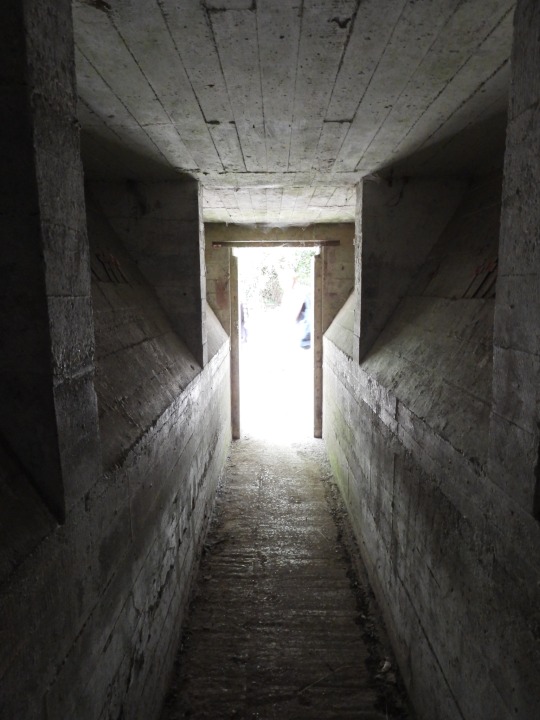
I do not consider John McCrae to be an evil man - he was of his time, and sincerely believed in the justice of his cause - hell, had I lived in his time, I might have agreed with him (and even today, I have very little sympathy for the German cause.) But I do consider In Flanders Fields to be an evil poem, a profoundly evil poem, because it not only inspired men to go to their deaths in Flanders and France, but it was used as a potent tool in the Borden government’s campaign to introduce conscription to Canada. I am not saying we should not recite this poem, but I am saying that we should think more carefully about what it really says.
McCrea isn’t buried in Flanders, but he’s commemorated here at Essex Farm Casualty Clearing Station, where the men he treated were buried. This was where we began today - the bunker in which the Canadian-run station was run remains on the site, and tributes are still left inside. Yet it’s not only the Canadians who have claim to this land - the 49th West Riding Division has its memorial obelisk here, and the cemetery is littered with the dead of the Yorkshire regiments that formed it. It’s a reminder that men often didn’t die instantly on the front line - they lingered, in ‘casualty clearing stations’ like this, often for days, until death finally claimed them. Some of them even suffered the final indignity of being looted by some of the more unscrupulous oderlies - the acronym of the Royal Army Medical Corps, RAMC, was sardinically corrupted by British troops into ‘Rob All My Comrades.’ (The British had a knack for this - NYD (‘Not Yet Diagnosed’) signs above medical cases became ‘Not Yet Dead.’)
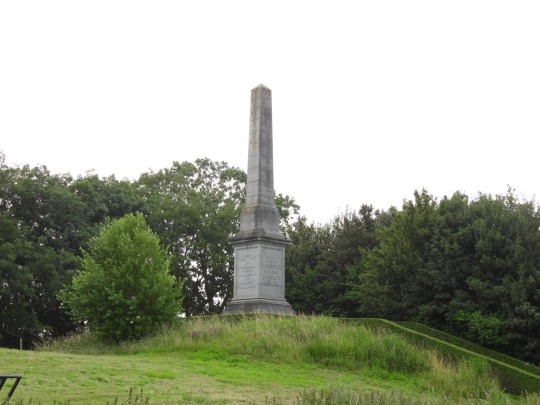
After Essex Farm, we entered Poperinge, which is a lovely town which I absolutely do not recommend visiting until they find out where that open sewer smell is coming from. (Perhaps they are trying to emulate the smell of frontline latrines?) Odour aside, there’s a fine Belgian memorial outside the cathedral there, but we were most interested in the Execution Post. There were dozens of these on all fronts - the Italians in particular were very profligate when it came to shooting their own men. In Poperinge, the execution site was outside the town hall, and today is a memorial to the men killed by their own side.
Men were, of course, shot for serious crimes - murder and rape were capital offenses. For the most part, however, they were shot for desertion, for refusing to fight, for dropping their weapons in the line of duty - essentially, for cowardice. Today, we know that soldiers can and do reach their limit, and that they need to be treated in compassion, but in 1917, PTSD wasn’t understood, and a man having a trauma induced panic attack could find himself judicially murdered by unsympathetic courts martial. Elsewhere, particularly in Italy, executable offensives could be truly absurd. One man was shot for failing to remove his pipe from his mouth when saluting. Other men from ‘underperforming’ units were shot at random to encourage the others - a revival of the Roman practice of decimation. It was not only the battlefield that could be pitiless.

We departed Poperinge and headed to Hill 60. Hill 60 was actually one of two points on one hill - the north was called ‘Hill 60’ while the southern portion was called ‘the Caterpillar.’ I say it ‘was’ one of these points, because Hill 60 and the Caterpillar are no longer there. Although this portion of the line was not on the Messines Ridge, it was attacked as part of General Herbert Plumer’s attack on the ridge in June 1917. Prior to the attack, tunnellers - famously the 1st Australian Tunneling Company, but also Canadian and British miners at various points - dug beneath German lines and planted massive mines beneath their strongpoints. On the 7th of June 1917, they were detonated. Hill 60, the Caterpillar and ten thousand German lives were extinguished in a pair of colossal explosions - just two of nineteen exploded that day. The assault that followed was a example of an unqualified British success - but the opening of the Third Battle of Ypres shortly after prevented much exploitation.
The craters remain, covered in grass, trees and water, but clearly visible as a scar upon the land. To see the sheer size of the crater at the Caterpillar, and to contemplate the sheer destructive power that caused it, is truly a sobering thing. This, effectively, is the grave of thousands of men - not that anything remained to be found after the mines went off. At very least, I suppose, it would have been quick.

We returned to Ypres for a quick lunch, and then headed back out to Tyne Cot Cemetery, where lie the dead of the late stages of the Passchendaele battles. This is the largest Commonwealth cemetery anywhere in the world, with 13,000 men interred within - a smaller number than Langemarck, but it must be remembered that the vast majority of them have individual graves or headstones. We were guided through by a CWGC intern, shown a few particular graves, and talked through the process of maintaining a cemetery and working for the CWGC.
Tyne Cot is so large that it is numbing. I remember staring at the endless rows of dead - 8000 of them are unknowns, and whole rows can consist of ‘Known Unto God’ repeated ad nauseum. The numberless dehumanised ‘blank’ graves, broken occasionally by one with a name and an epitaph, put me in the mind of old pictures of units before and after major battles - a full parade ground before, a few dozen men afterwards. It made me think of one of those dark trench songs - ‘if you want the old battalion, I know where they are. They’re hanging on the old barbed wire.’

We moved on from Tyne Cot to the Flanders Field American Cemetery. In the last few months of the war, two American divisions - initially the 27th and 30th Divisions, then the 37th and 91st Divisions - fought under British and Belgian command in the last battles around Ypres and the Lys. This was contrary to General John Pershing, the American commander’s, belief that Americans ought to fight under their own command in their own units (a policy that, alongside Pershing’s complete refusal to take advice from the British and the French, led to proportionately higher casualties amongst US forces.) I’m not quite sure why the Americans let these divisions fight with the other Allies, but my guess is that they politically felt they ought to be shown to be fighting in Belgium.
We were guided around the cemetery by the superintendent there, and it reminded me of how differently the United States thinks of the First World War (if they do at all of course.) The Americans frame their involvement in the war as a sacrifice for freedom - the freedom of the Belgians in particular being emphasised here. They’re not so much on the mud and blood as they are on the duty and heroism. I don’t think they’re necessarily wrong - Belgium was absolutely fighting for it’s freedom from the Germans - but I think their outlook reflects the limited amount of time they spent fighting in the war. The Americans didn’t really experience disillusionment with modern war until Vietnam - they were only in the tail end of the First World War, and the Second was fought against such an unambiguously evil opponent that it would be hard to form a pacifistic argument against it.) Add that to the current attitude towards soldiers and veterans in America today, which is in itself a reaction to how Vietnam veterans were treated, and the US attitude to it’s First World War isn’t surprising at all.
It’s unsurprising, but the way the superintendent danced around anything that might have come off as critical of the US war effort was a little bit troubling. One doesn’t have to be a pacifist to say that attacks launched hours or minutes before the armistice were probably pointless - and yet he seemed almost to justify them. I’m sure that’s just the line he’s been told to say, but just because these doughboys were still ‘on the clock’ didn’t mean they had to die on the altar of Pershing’s vanity.
Can you tell I don’t think much of Pershing?
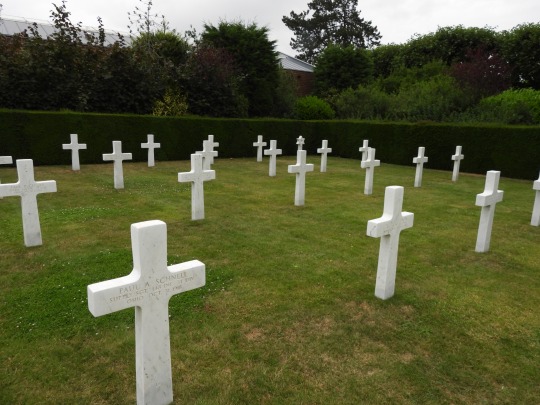
We went back to Ypres again, had a little break, and met beside (what we could see of) the Menin Gate for a discussion of that. I had volunteered to read Siegfried Sassoon’s ‘On Passing the New Menin Gate,’ which is one of Sassoon’s angrier works, and I quickly regretted it as the park we were standing in was soon occupied by a lot of old men in Royal British Legion suits and guys with tattoos who looked like they could steamroll me in a fight - but they’d all gone by the time it came to speak, and I managed to read it without having my arse ripped out through my mouth by an angry ex-serviceman.
We headed down to the Last Post ceremony. Ken Inglis once said that rituals are most interesting when they go wrong, so he’d have loved this one. First of all, the entire Menin Gate was covered in scaffolding, so it was like half of Ypres had congregated in front of a construction site. The crowd was such that nobody could see, so a sea of arms holding phones emerged from the mass of people. Then the ceremony began, and silence fell, save for the ringing of bicycle chains as a band of cyclists for Prostrate Cancer UK, wearing form-fitting, neon blue bike suits, rolled up to see what was happening. The Last Post was sounded, and then ‘quiet’ as dignitaries and school children lay wreaths. I say ‘quiet’ because one motorist drove past the barrier and nudged his way through the crowd to get home a little more quickly, and a few kids down the road were miming guns and shouting ‘Pew! Pew! Pew!’ One kid in a red shirt was either miming being shot or dancing, I’m still not certain which. Halfway through, the Prostrate Cancer guys got bored and cycled away. A man from the Royal British Legion stood behind me, and I noticed him die a little more inside at every absurdity. A piper began to play, and immediately hit a bum note. All the while, Belgian pedestrians walked past, some still talking or whistling as they did. The ceremony didn’t so much end as it petered out - the bugle stopped, silence turned to confused mumbling and then speaking, and then a great wave of people stumbled forwards, through the scaffolding and into town - the vast majority headed for pubs and bars.
It wasn’t a very solemn or moving occasion, but it was sure as hell entertaining.

I would like to end on a little indulgence. All day, I have wanted to read a poem as a sort of rebuttal to In Flanders Fields, but time simply wasn’t on my side. As a result, I’m just going to print it here. This is Wilfred Owen’s Anthem for Doomed Youth - the spiritual antithesis, in my opinion, to John McCrae.
What passing-bells for these who die as cattle?
— Only the monstrous anger of the guns.
Only the stuttering rifles' rapid rattle
Can patter out their hasty orisons.
No mockeries now for them; no prayers nor bells;
Nor any voice of mourning save the choirs,—
The shrill, demented choirs of wailing shells;
And bugles calling for them from sad shires.
What candles may be held to speed them all?
Not in the hands of boys, but in their eyes
Shall shine the holy glimmers of goodbyes.
The pallor of girls' brows shall be their pall;
Their flowers the tenderness of patient minds,
And each slow dusk a drawing-down of blinds.
2 notes
·
View notes
Text
28 June 2023
The Salient
Ypres
28 June 2023
In military teminology, a salient is when part of one side’s territory sort of bulges into the other side’s. Imagine you have two lines of paint, one red and one blue, running parallel, and they’re slightly wet and runny. Imagine a bit of the red paint leaking into the blue line. Picture that, and you’ve got a fairly good idea of what a salient looks like on a map.
From a purely military perspective, you don’t want a salient. A salient means that the enemy has positions on your flanks that can provide enfilade fire - effectively, they can hit you from the front and from both your left and right. It is much better to defend a straight line - or better yet, have the enemy in a salient pushing into your line. From a purely military perspective, what the British and French should have done in November 1914, when the fronts began to harden into what would become trench warfare, was to fall back and abandon the town of Ypres to the Germans. Politically, this was impossible - Ypres was the last Belgian town of any note held by the Allies, and to abandon it would be to abandon the country altogether. Since Britain had entered the war to defend Belgium, this was unthinkable.
Hence, the Ypres Salient, established after the First Battle of Ypres in November 1914 and crystalised after the Second in February to March 1915 (the latter being the first used of poison gas in modern warfare, and the first major battle fought by the Canadians.) For the troops of the British Empire, Ypres was always a bad place to be posted - but it was in the summer and autumn of 1917, during the Third Battle of Ypres, that the name became synonymous with hell on Earth.

I have some sympathy with Field Marshal Haig, at least in the early stages of the battle - the Allied badly needed a win. The French Army, after the disastrous Nivelle Offensive of early 1917, was in a state of mutiny. The Italians were foundering in the Alps and were about to be utterly hammered by the Germans and Austro-Hungarians at Caperetto. The Russian Army was disintergrating as the country fell into revolution. Of the main Allied powers, only the British had a functioning army. The burden fell on them. What I cannot sympathise with Haig on, of course, was the fact that the battle continued long after it made any sense to keep going. By October and November, in a morass of mud, gas, artillery and blood, the British Army was nearly bled white in a series of pointless offensive to take the blasted ruin of Passchendaele. It would be given up without a fight in the German offensives the following spring.
If you want the answer as to why the Allied appeased Hitler, you can find it in the rows and rows of tombstones in this small strip of Belgian land.
We started today with a brief walk along the walls of Ypres - they date back to Louis XIV, who built a lot of forts because he had a lot of enemies. (For the fortification nerds among you, I can’t remember if it’s a Vauban fort, but I suspect it probably was.) At the Lille gate, so called because it faces that city, we reached the Ramparts Cemetary. Most of the men buried here were killed in the Second Battle of Ypres in 1915, but there are clusters of 1917 names - little groups of men, all from the same battalions, all from the same day. Of particular note were about six men of the Maori Battalion, all of whom died on New Years’ Eve 1917. The men in these graves would have died all at once, victims of a direct hit from an artillery shell. One could escape snipers, machine guns, even gas, but at Wipers, a ‘whizzbang’ could always find you.
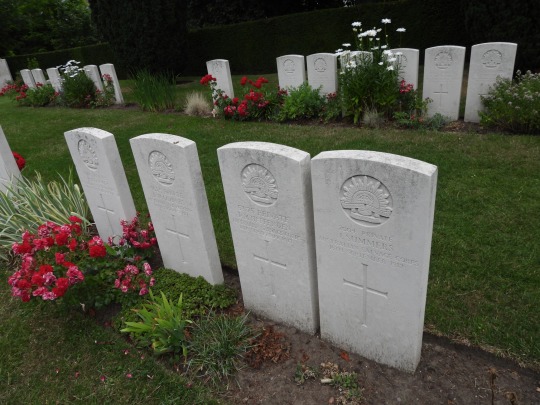
We met our new bus (apparently yesterday’s bus has been fired) and left Ypres for the second cemetery of our day’s touring, and perhaps the most unique I’ve ever seen. The Langemarck German Cemetary is one of the bleakest places I have ever visited. Slabs on the ground mark the dead - tens at a time - in what I can only describe as a pitiless mass grave of humanity. A distubingly large portion of these men died in October 1914, many of them cadets - these were the Kindermord bei Ypern, and their pointless, suicidal attacks on British positions were turned by their leaders into a propaganda tool to encourage young men to emulate their ‘sacrifice.’
There are over forty-four thousand German soldiers interred at Langemarck. This was because the Germans were given precious little room for burials after the war - the Belgians and French, pitlessly but somewhat understandably, called the bodies of German soldier ‘pollutants’ in their soil. As a result, German graves on the Western Front are filled to the burst point with wasted humanity. Of course it became a site of Nazi pilgrimage after the German conquest in 1940, and in an attempt to prevent this from happening again, the cemetary has interpretive spaces that a visitor must pass through to access the cemetery. That is the saddest thing about German cemeteries, I think - if they had a beautiful cemetery like the British and French do, it would immediately become a Mecca for fascists. One only needs to look at the grave of SS tank commander Michael Wittman, who despite being a Nazi of the worst stripe, still had tributes laid at his grave almost daily.

My personal verdict, though? Langemarck is obscene. It is dehumanising, alienating and almost industrial. When Seigfried Sassoon spoke of the ‘intolerably nameless names’ at the Menin Gate, he might very well have spoken about this. That there is probably no other option does little to reconcile me to this pit of inhumanity. Perhaps in that way it’s one of the best anti-war arguments I’ve ever seen.
We left Langemarck, passing the Brooding Soldier, a Canadian memorial to their victims of has attacks, and heading on to Polygon Wood. This is where the Australian Fifth Division chose to place their war memorial. The Australian Imperial Force in France had five infantry divisions - there was a sixth, the Mounted Division, in Palestine - and these were predictably numbered from one to five. The Fifth, the youngest of them, had perhaps the worst introduction to the war of all, starting their campaign at Fromelles, an unmitiagated failure of an offensive that still holds the dubious distinction of being the bloodiest day in Australian history. For reasons that are probably obvious, they didn’t chose to build their memorial at Fromelles - they chose Polygon Wood, part of the push towards Passchendaele. This is because Polygon Wood, by the standards of the Western Front in 1917, was actually a success - the Fifth took all of its objectives with ‘acceptable’ losses.
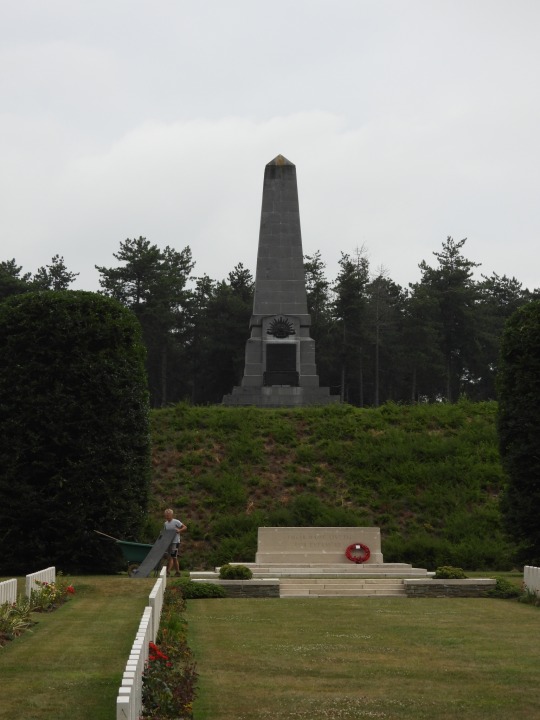
In a weird way, after Langemarck the graves at Polygon Wood seemed almost reassuring; yet it was confronting in its own way. Technically, the cemetery around the Fifth Division Memorial isn’t part of the actual Polygon Wood Cemetary - it’s the Butte New British Cemetary, and that’s pronounced like ‘boot’ you absolute children. But they’re effectively the same complex, and both of them are filled with dead Australians, New Zealanders and Britons. There are whole lines of headstones labelled ‘Known Unto God’ - these are the unknown soldiers, the men so badly mutiliated that they could not be identified. Some could be traced to a unit, a rank or a nationality - ‘an unknown Australian soldier,’ ‘an unknown soldier of the Manchester Regiment,’ ‘an unknown Australian Second Lieutenant’ - but that does little to erase the sense of cruel anonymity. Even so, people still lay tributes at these graves - poppies, flags, little wooden crosses. I’ve always liked that - people who don’t know and can’t know who these men were, but are willing to stop by their grave regardless. There was an unknown soldier with an Australian flag laid on it, and I was a little curious as it stood right next to one that was explicitly identified as Australia. Perhaps whoever left that flag was saying that, whether or not you were a Digger or a Tommy or a Kiwi in life, you’re in our house now, and you’re one of us.
I think it was the historian Mark McKenna who questioned the sincerity of those who make pilgrimage to foreign battle sites and mourn. Everytime I go to one of these places, I think they prove him a little more wrong.

We rambled into Polygon Wood itself, behind the cemetery, and found ‘Scott House.’ This is actually not a house, but a pillbox, taken by Australian forces in the battle. This would have been at the edge of the Hindenburg Line (or the Siegfried Line in German, not to be confused with the line of the same name in the Second World War.) The Hindenburg Line was built behind the German front at the end of 1916, after the Germans had taken a severe battering at the Somme and Verdun. They withdrew to it in the Spring of 1917, and it basically remained the frontline until Germany took the offensive again in 1918. It was something of a master stroke, and was really more of a series of mutually supporting lines of trenches, blockhouses, barbed wire and mines, funnelling the enemy into killing zones where they could be destroyed. It could also be manned by fewer men, allowing Germany to divert troops to the East to crush Russia. The fact that the blockhouse is still intact, over a century later, is a testament to its strength. Of course, in the end, the Hindenburg Line was cracked - or perhaps shattered was the better term. But we’ll get to that in a few days.
After leaving Polygon Wood, we briefly scouted past Tyne Cot - we’ll head back there tomorrow - and returned to Ypres for lunch. After lunch we headed to the In Flanders Fields Museum, in the rebuilt Cloth Hall at the centre of town. This museum has two basic functions - it’s a museum, recounting the history of the war in Belgium in general and in Ypres particularly, and the personal experiences of combatants and civilians, and it’s a memorial, explicitly designed to do justice to those who died in the Ypres Salient and to promote peace. There are things in it I disagree with in it (mostly the generic references to ‘the State’ in the first part of the memorial - all pre-war nations had their flaws, but I don’t think they can all be lumped together 1984-style as one generically malevolent ‘State’) but ultimately I very much recommend this museum. I think there’s a lot in there that other museums could learn from.

As I am wont to do, I’ve put some thought into an exhibit that really spoke to me. I think it’s the layouts of uniforms and equipment of the main combatants (with the somewhat bizarre exception of Britain, but I think that’s because most of their kit overlaps with the Canadians and Australians rather than any particular statement about ‘perfidious Albion’) as they were in 1918. Firstly, they’re laid out in such a way that it’s easy to see exactly what kit a soldier would be carrying, as opposed to being on a mannequin in full battle order (although don’t get me wrong, I love a good mannequin.) Secondly is the presentation - everything looks like it’s attached to a sprue, like a model kit. I don’t know if that’s intentional, but it gives everything a bit of a toy soldier feel - perhaps a sneaky little tweak on the nose at people with unhealthy interests in uniforms and guns (which I understand describes me, but I’m not above a little healthy self-reflection.) There was also a pretty neat exhibition on the Commonwealth War Graves Commission and its French, Belgian, US and German counterparts.

We had a chat with the staff at the museum, and then that was it. I went to Ypres Burger, because I find it conceptually entertaining, and called it a day there. Tomorrow, we’re going to talk about a famous and evocative poem that sits a little funny with me…
…no, it’s not Rupert Brook’s The Soldier. That doesn’t ‘sit funny’ with me, I hate it with white hot intensity. ‘That is forever England’ my bottom.
2 notes
·
View notes
Text
All going well, I shall post the Western Front section of the trip tomorrow!
0 notes
Text
27 June 2023
Far, Far To Wipers
Ypres
27 June 2023
It is one thing to order a unit to go somewhere. It’s quite another for it to get there.
A division of men might contain up to twenty thousand men, and is not something that can be casually slipped into and out of the line. Even in today’s world of heavy aircraft and fast carriers, it’s no east feat - in the First World War, it could be a nightmare. To get to the front, you would need to move your men over an often overtaxed railway system to the nearest railhead to your sector - these railheads, such as Amiens, were of enormous strategic value. If you were lucky, you might be able to use trucks to carry your men on, or utilise the considerable light railway network that was established behind the front lines. Nine times out of ten, you had to walk. By the mid-to-late war, the roads between the railheads and the front would have been blasted to pieces, and would be presighted for artillery and mortars, so that walk to the front would have been a long and painful ordeal - and that’s before you factor in the mud of the awful winter of 1916-17, or the Third Battle of Ypres. On the other fronts, of course, it was even worse - men in Mesopotamia and Palestine would have had to trudge through the desert to reach their posts.
We cannot, of course, imagine these ordeals, but that doesn’t mean the modern travel industry can’t find new and interesting ways to torture us.
We left Gallipoli before dawn, and for the first part of the trip, things went swimmingly. We reached Istanbul airport by 9, were through security by about 10.15, and boarded the plane in good time. Some of the group did get separated, but they were found - and as far as flights go, it was pretty straightforward.
Then we landed in Brussels.
Never, in my entire life, have I waited as long in passport control as I did today. I was in that queue for two hours. Two hours to get a passport stamped, in the capital city of the European Union. When it’s harder to get into Belgium than it is to get into Erdogan’s Turkey, there’s a problem.
By the time we emerged from customs, we were all pretty narked. We got into our new bus and immediately hit rush hour traffic getting out of Brussels, then more going through Ghent, so by the time we reached Ypres, any hope of any evening memorial visitation was gone. Still, we were able to check in. I had a shower and decided I could at least console myself with a look at the Menin Gate, and…

…sometimes, you just have to laugh.
2 notes
·
View notes
Text
26 June 2023
The End of the Beginning
Gallipoli
26 June 2023
In the end, it was not the great and distinguished generals like Hamilton, Birdwood or Hunter-Weston that planned the final withdrawal from Gallipoli. The failure of the August Offensive was the last nail in the coffin for Hamilton’s career, and he was removed shortly after. Hunter-Weston had been invalidated in the midsummer (although he would be inflicted upon the army again at the Somme), and Stopford had been quietly returned to retirement. General Munro, Hamilton’s unromantic successor, and Lord Kitchener, who had visited the Peninsula shortly after the August debacle, had decided to pull the plug. Now came the task of getting out.
Birdwood remained, of course, but the evacuation of Anzac was not his brainchild. It was Colonel Brudenell White, his chief staff officer, who largely planned it. One of the great ironies of Gallipoli is that the only time thoughtful and considered planning and staffwork was properly done was at the very end. Under White, and his IX Corps counterpart at Suvla whose name unfortunately escapes me right now, men, stores and weapons were quietly lifted from the peninsula, until at last the final men left before dawn on the 20th of December. The evacuations of Anzac and Suvla were completed with nearly no casualties. There’s some spectualtion today as to whether or not the Ottomans simply allowed the Allies to go. I’m not convinced of this - Kemal in particular was not the kind of man to let thousands of Allied troops, many of whom would go on to fight the Ottoman Empire else where, simply slip away into the night.
Helles would be maintained until 21 January 1916, but eventually it too was quietly and successfully evacuated. The last man to leave was General Stanley Maude, who would go on to die of cholera in the Mesopotamia campaign. The second last man to go was Major Clement Attlee. ‘Major Attlee,’ as he was called between the wars, would go on to become a Labour Prime Minister, defeating Churchill in 1945.

Our time at Anzac today was brief. We first headed to Green Hill Cemetary, which was about as far into the Suvla sector as our bus could go. Unlike Anzac, which was officially ceded to the Australian government - yes, that’s true, although we don’t claim sovereignty now we do technically own the land - Suvla remained Turkish territory after the war. The cemetaries there are necessarily consolidated. This also meant that the Imperial War Graves Commission, rather than sticking to battlefield positions, were able to create more traditional cemeteries here. Green Hill, whose layout somewhat sneakily resembles a cross, therefore looks a lot like the cemeteries I’ve seen in France, Belgium and the Netherlands.
It is also here that, even amongst the myriad tragedies of Gallipoli, a particularly wasted life stands out. Private Harry Salter, 6th East Lancashires, was aged 19 at Suvla, though he clearly lied about his age as his grave says he was 24. Salter was charged - and this is related in an account by Private Edward Roe - with taking ‘French leave,’ leaving his sector to go to Anzac. He was found guilty of desertion - even though Roe points out that desertion at Gallipoli was impossible, every square inch of land being under threat of Turkish fire. On the 11th of December, ten days before the end of the campaign, he was taken to an abandoned quarry in the Suvla sector and shot.
‘I only wish,’ Roe writes, ‘that the distinguished person who signed the death warrent without taking into consideration the extenuating circumstances would leave his comfortable island residence and visit the men under his command who were going through it.’ Roe was one of the firing party.

We proceeded to the Anzac Commemorative Area on North Beach, our last stop on Gallipoli. This was created in 2000 and there’s a plaque with the names of the then Australian and New Zealand Prime Ministers - this means, quite outrageously, that the only names enshrined here are those of John Howard and Helen Clark. All leaders use the past, but Old John is particularly infamous among historians for weaponising it in the so-called ‘History Wars.’ There is something obscene about his name being here. Then again, the ‘memorial’ here is very much out of the Howard-Nelson playbook. There are deeply sanitized placards that minimize nearly everyone who wasn’t Australian or New Zealander. The British get a few terse mentions, mostly in the context of failure, the Indians get one token mention, and the Gurkhas and Newfoundlanders are totally out of luck.
It’s here that commemorative events are held every 25th of April at dawn. For most people who attend, I’m sure, it’s a beautiful and moving experience, but the diginitaries - the Prime Ministers, ambassadors and all those ‘great and good’ - do not stay here. They ride in on buses and cars before dawn, and they ride straight back out when it’s done. Apart from maybe the Prime Ministers, they don’t visit the graves, nor do they contemplate the site. This is just part of the diplomatic calander, a nice little gesture between Canberra and Istanbul (or Wellington and Istanbul) to smooth the passing of treaties or trade deals. They just have to be quiet for one minute and look like they’re thinking of one war, and then they can go back to planning the next.

People should come to Gallipoli, and not just Australians, New Zealanders or Turks. But they shouldn’t come here for that great ceremony - they should come now, or in August, or even in the winter when the landscape is covered in ice and snow. They should explore it themselves - go to the cemetaries, not just ours but everybodies, and gaze upon those names. Walk the ground. Trace the landscape. Gaze into the sea and think of the ships that still rest there. Come up with your own conclusions about it. Don’t take what the AWM or the Turkish Government or anyone else - including me, for that matter - as gospel.
Was it all a waste? Was it sacrifice? Heroism? Crime? I can’t tell you that. Go to Plugge’s Plateau, or V Beach, or Chunuk Bair - look out over the landscape, and there you will receive the answer.
Of course, this is true of any battlefield. They all say different things, and they say them to different people. Gallipoli and Normandy were both amphibious operations, but one screamed to me about pointless, idiotic waste, and the other spoke solemly of the suffering needed to put an end to perhaps the most awful regime in history. They may say something else to others.
(This is all metaphorical by the way. I am not actually hearing the ground talking to me. I’m not that mad.)

This brought my Gallipoli adventure to a close. The others went on a boat to snorkel over a wrecked landing barge, but I saw that boat while we were at North Beach and I decided that discretion was the better part of valour and stayed back at the hotel in air-conditioned comfort. We leave Turkey tomorrow, and I’ll miss it more than I expected, but I’ll also be very glad for the change of scenary.
For you see, the story didn’t end at Gallipoli - in fact, Gallipoli was in many ways a spin-off of the main tale. For as much as the British government wished it wasn’t, the war was only going to be won or lost in one place. The men at Gallipoli had departed hell, but they were now bound for the Western Front…
2 notes
·
View notes
Text
25 June 2023
Consigned to the Deep
Gallipoli
25 June 2023
The battleships that made up Admiral John de Robeck’s fleet on the 18th of March 1915 weren’t really the apex of the British and French navies. Apart from the ultra-modern Queen Elizabeth, a ‘super-dreadnought’ with fifteen inch guns, and the battlecruiser Inflexible, the fleet was a bit like entering a fleet of VW Beetles into a V8 Supercars race at Bathurst. These old battlewagons - ‘pre-dreadnoughts,’ as they predated the revolutionary HMS Dreadnought which was faster, hardier and better armed then all that came before her - were elderly, almost geriatric in naval terms. The French Bouvet dated back to 1893.
Nevertheless, even old battleships can make a considerable impression when one has eighteen of them, and on that March day, de Robeck hoped to utilise his apparently superior firepower to blast the Turkish forts covering the ‘Narrows,’ while civilian ships swept the mines blocking his path. Once through the Dardanelles, he would be into the Sea of Mamara, with only the German-crewed battlecruiser Yavuz, formerly Goeben, between his fleet and the Bosphorous. They would place Constantinople under the guns and force the surrender of the Ottoman Empire.
It is this day that the Turkish people commemorate - not the 25th of April. Here, the Ottoman defenders in the forts and on the howitzers covering the Narrows stared down the might of the most powerful navies in the world and held them off. Precious battleships were badly damaged, as was Inflexible. Bouvet hit a mine and was lost with all but seventy-five of her crew. HMS Ocean, moving to assist, was struck by shellfire and further mines and had to be abandoned, as was HMS Irrestable. Far from an easy victory, the Naval Battle of the Dardanelles had become an expensive setback.
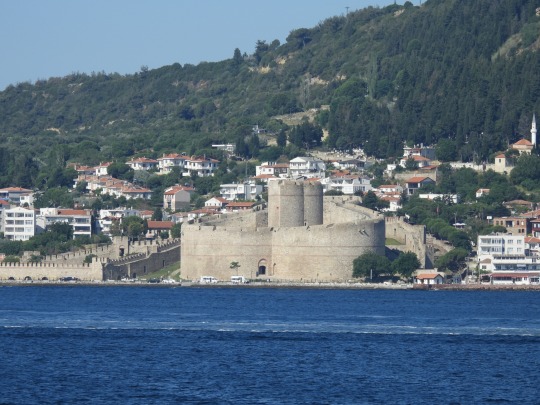
In truth, the British were breaking a key rule of naval warfare, one set down by Lord Nelson himself - ‘a ship’s a fool to fight a fort.’ You do not send your ship to fight a gunnery duel with fortifications - that is what your marines are for. Like everything else about this squalid campaign, the effort of the 18th of March was doomed. This does not invalidate the bravery of the Turks, nor does it denigrate their performance, particularly in quickly moving artillery to protect it from naval gunfire. It’s simply another example of the almost criminally haphazard planning of the operation.
This was a very longwinded way to tell you that I crossed the Narrows today, isn’t it?
The town of Canakkale sits on the Asian side of the Dardanelles - the Gallipoli Peninsula is on the European side, on that little bit of Turkey that borders Greece and Bulgaria. (This was actually important during the war - the entry of Bulgaria into the war on Germany’s side in October 1915 was one of the last nails in the coffin of the Gallipoli campaign, and troops were now sent to join the even more idiotic campaign at Salonika in Greece.) To get there from Gallipoli, one has to cross via car ferry, which gives excellent views of the landscape around the Narrows. If you listen carefully as you look at the preserved forts, you can hear Nelson rolling in his grave.
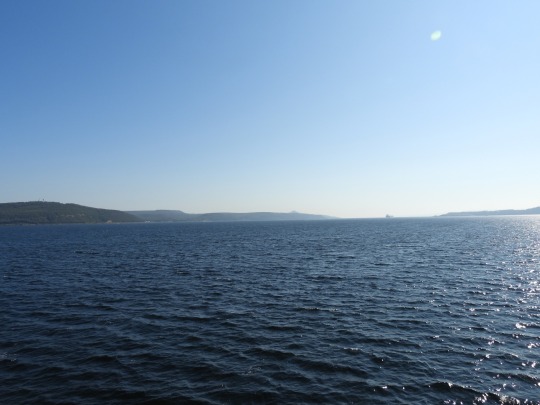
We reached the Asian side of the Dardanelles around 9.30 and drove a little way out of town to the (alleged) site of Troy. (I say ‘alleged’ of course because we don’t really know if this is actually, or if Troy actually existed. My theory is that Homer conflated a number of towns and conflicts into ‘Troy’ and ‘the Trojan War.’ Or he might have just been wrong - Homers aren’t known for being smart.) My verdict on the site? Well, there’s bricks. There’s holes. There’s bricks in holes. There was definitely a city here once, but most of what we can say about it is educated guesswork. So I looked at these bricks, I said ‘yep,’ and then I went to the cafe and had an ice cream. That was my adventure in Troy - my Troy Story, if you will.
(I’ve always preferred Woodyseus to Oddyseus anyway.)
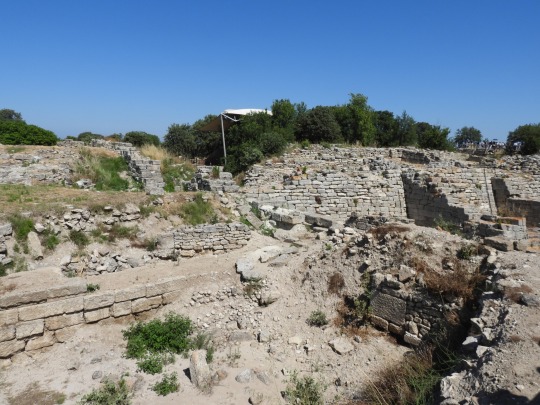
We returned to Cannakkale and were unleashed upon the town for a few hours, so naturally I found a naval museum. This is based around an old fort that dates from the reign of Mehmet the Conquerer - the fifteenth century sultan who captured Constantinople and destroyed the last remnant of the Eastern Roman Empire. The grounds now serve as a staging post for an eclectic mix of naval and land artillery, mines, torpedoes and even the skeleton of a First World War German U-Boat, recovered from the deep. There’s also a fibreglass replica of the minesweeper Nusret, but quite alarmingly I couldn’t find it. I sincerely hope the museum remembered to tie it up, or it might be halfway to Malta by now.
Inside the keep is a Turkish museum about the Gallipoli campaign. It isn’t terribly modest, and I noted a few errors (a diorama of W Beach seems to be mislabelled as V Beach), but it didn’t strike me as too odd to see a museum in which ‘we’ are the bad guys. If one changed the word ‘martyred’ for ‘sacrified,’ and the word ‘Turkish’ for ‘Anzac,’ this could be a wing in an Australian museum. There was also a little more music than a comparable museum in Australia - at least for now, the last thing we want to do is give the AWM ideas. (I remember the First World War gallery having this sad song playing over the exit for a while - it was meant to be evocative, but all it really evoked was the sensation of having your eardrums blasted out any time you dared to go near the 1918 section. It was the equivalent of having Brendan Nelson smash you over the head with a shovel while screaming at you to feel ‘proud but sad.’)

We headed back to Gallipoli at around 4pm. I rested for a while. Maddi did not, as she and our professor reconnitered Rhododendron Ridge to test it’s viability for a group walk. We had meant to do Walker’s Ridge, but erosion in that area has become so great that it barely exists anymore, and walking it in any numbers would have been impossible. Rhododendron, the path the New Zealanders walked to Chunuk Bair, was the alternative, and the scout party found it workable. Maddi’s reward was to go right back to Chunuk Bair, join the group, and do it all again.
Our professor, I must add, is about sixty-seven years old. He has the energy of someone a tenth of his age. This leads to the absurd image of a mild-mannered bespectacled man with grey hair leaping and bounding over the most precarious ground ahead of a whole group of exhausted, sweaty twenty-somethings who can’t navigate a small bump in the track without slowing to a crawl. He would be standing on the narrowest, wildest part of the trail, motioning us forward as if we were strolling the Strand, and I’d be fifty meters back contemplating calling for a surgeon to saw off both my legs.
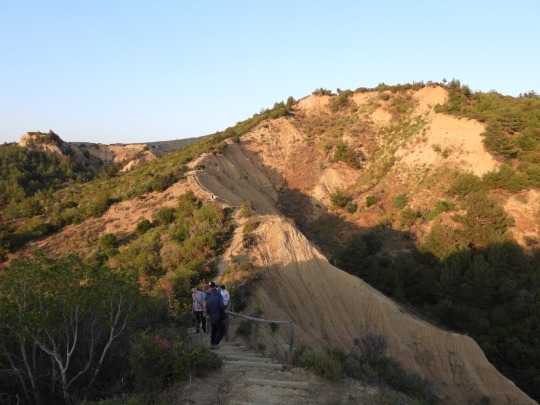
The walk, arduous though it was, was absolutely stunning, with amazing views of Monash Valley, the Nek, and out towards both Anzac Cove and Suvla Bay. It’s littered with the detritus of the campaign - we found a button from an Australian soldier’s tunic and a rum bottle buried in the ground. Both of these we left. Our professor is of the opinion that the relics found at Gallipoli should stay where they were found. I’m personally conflicted. I think some of this should be preserved so that they don’t simply rust away, but I’m also aware that - as Bean himself said - the whole of Gallipoli is one massive grave, and perhaps taking them to a museum could be considered grave-robbing. I suppose it depends on your morals.
I would be remiss if I didn’t mention our scout here - Lance-Corporal Nigel, who journeyed with us all the way from Chunuk Bair to the sea.

We ended at the Embankment Cemetary, returned to the bus, and headed back to base. My feet hurt and I think I’ll be picking brambles out of my socks for days (even accounting for my wearing of cargo pants), but I’m very glad I did the walk. I think ordeal is often a part of visiting battlefields - if they could fight here, the least we can do is shed a little sweat. But my body yearns for a soft bed, and I can no longer deny it, so we’ll leave this for tonight here.
2 notes
·
View notes
Text
24 June 2023
The Best Seat in the House
Gallipoli
24 June 2023
One thing I try to emphasise whenever I discuss it was how pointless the Gallipoli Campaign really was. What ifs are popular in military history; what if Napoleon had attacked Wellington at 11am instead of 1pm at Waterloo? What if the Nijmegen Bridge had been captured on the first day of Operation Market Garden? At Waterloo and Nijmegen, these counterfactuals have merit; there is a legitimate possibility that these actions could have altered the outcome of the battle. There is no such merit here - there’s no road to Constantinople from the Sari Bair Ridge. There isn’t even a road to the Dardanelles.
We departed at 8.30am and headed to the nucleus of Australian commemoration at Gallipoli - Lone Pine. Lone Pine was technically one of the very few - indeed, probably the only - successes of the so-called August Offensive. We’re going to be talking about August a lot, so here’s a quick rundown of what happened.
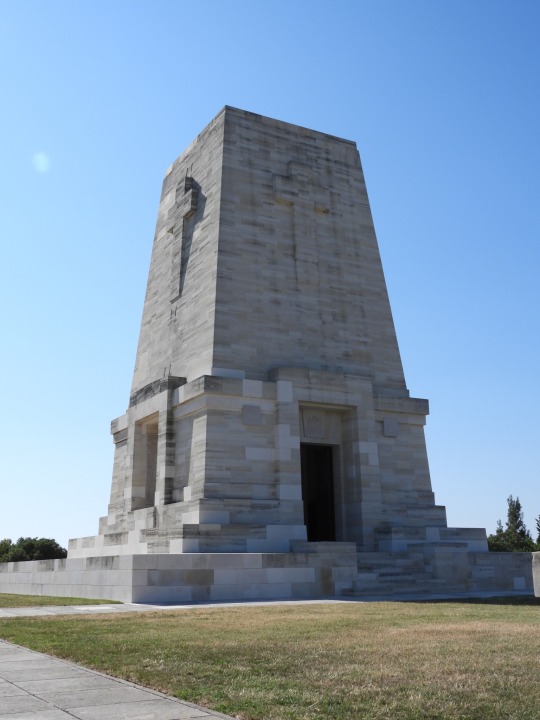
Wars are conducted on three layers; tactical, operational and strategic. August had a vague strategic objective - the Sari Bair Ridge and Chanak Bair in particular - but the operational objective was nearly nonexistent. Very little thought seems to have been put into what was meant to happen once the ridge was captured, and there remained a significant distance from there to the Dardanelles. As for the tactical layer, the objectives were clear enough, but the execution of the attacks were mediocre at best and catastrophically incompetent at worst. The failure of the August Offensive lead to the sacking of Hamilton and, in time, the abandonment of the whole campaign.
Lone Pine was carried, but it was largely a diversion for the main efforts elsewhere, which rather rendered the whole thing a pointless waste of life. Nevertheless, the fact that it was technically a victory counts a lot in Australian memory, and it was inevitable that the main Australian memorial would be built here. As far as memorials go, it’s almost underwhelming compared to the poignance of the Beach Cemetaries or Shrapnel Gully, and it lacks the architectural interest of the memorial at Helles. It surprises me that perhaps the most sacred of the Australian memorials, save for the AWM and Villers-Bretanneux, didn’t speak much to be. Perhaps it’s simply that I’m reaching a point where one tower with a cross etched on it starts to look a lot like all the others.

We walked from Lone Pine down to Artillery Road. As the name implies, this road was used to lug artillery guns up to the heights, a backbreaking task in rough terrain. The roughness of the trail, I am told, remained evident as late as 2019, but the authorities have now widened it significantly, creating a great scar in the land from Lone Pine to Anzac Cove. It’s worth noting that this widening project was almost certainly the brainchild of the Australian government - or was at very least done with their support.
On the way down, we stopped at Shell Green. This is one of those places that ended up enshrined in Anzac folklore - it was here, on the last days of the campaign, that Australian troops played cricket under the eyes of the enemy to convince them that they meant to stick around. It’s said that the watching Turks chose sides and cheered along. Here we discussed the concept of emotional truth and accuracy in regards to memoirs; a key rule to interrogating memoirs is that not every inaccuracy is a bald-faced lie. A man might write that he came ashore on the 25th of April but may actually have come ashore on the 27th, but through the vagaries of memory he might believe he came in on the landing day - or a publisher may simply change the date to sell copies of the book. In any case, the date doesn’t matter so much as his experiences - we don’t need to know the exact time a man saw his brother blown to pieces. In such a situation I can think of nothing that matters less.
Shortly thereafter we found some turtles.
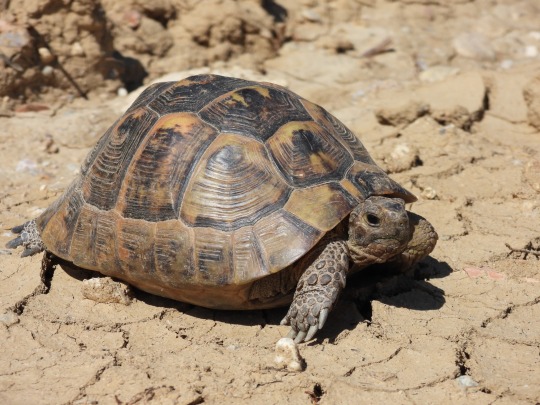
At the end of Artillery Road we rejoined the bus and drove to Beach Cemetary, not to be confused with Beach Cemetary - there’s two of them. This Beach Cemetary, which is a little south of the other one, is where Private John Simpson Kirkpatrick is buried. All Australians know the story of the great Aussie battler with his donkey, going out under fire to save his wounded mates until he is eventually killed in the line of duty. A true, blue Australian and an Anzac. There’s just one problem - nearly none of that is true. He absolutely did help the wounded, with a number of donkeys, but he was one of dozens of others carrying out this vital work and wasn’t terribly exceptional in this regard. Brave though he was, he didn’t join the AIF out of patriotism for country or empire - in fact he despised the empire - and fully intended to desert once the Australians made it to London. The reason for this, and the big kicker, is that Simpson, that greatest Australian hero, was an Englishman.
The great absurdity is that Simpson, a English socialist who’d deserted a merchant ship four years earlier, somehow ended up being picked up by both the Red Cross and Australia as an example of the bravery of all the medics and the stretcher bearers, and was inflated to such a point that the person on the street now probably believes there only ever was one stretcher-bearer at Gallipoli. This is not such a great thing for the scores of other men buried at Beach Cemetary - Australian, New Zealander, British and Indian - as Simpson catches the lion’s share of everyone’s attention. The entire thing is a little bit insane, and runs contrary to the idea of Anzac as an egalitarian tradition.

After a brief stop at Embarkation Pier (where there is no pier and where nobody actually embarked) we returned to the hotel to wait out the heat of the day. At 4.30pm we reconvened at the hotel library, watched the last third of Peter Weir’s Gallipoli, and headed back to the Second Ridge to Quinn’s Post.
There are thousands of men buried on the Gallipoli Peninsular - tens of thousands in fact. All of them are equal in death. Yet there is one that I had to elevate above the others - and that is because he’s one of mine. Private D. H. Ellem, 15th Battalion, landed on the first day of the campaign. He was at Gallipoli for a week, and was killed at Quinn’s Post on the 1st of May 1915. There he remains. Quinn’s Post was the site of some of the most violent fighting of the campaign - it was called ‘the Haunted House,’ for the cries of the wounded there echoed all around. Private Thomas Charles Scates of the Royal Marines described it simply as a ‘death trap.’ Today, the view of the endless sea is astounding, especially from Private Ellem’s position. He sits right in front of the great memorial stone at the head of the cemetery. It is the best seat in the house.

Before photographs, families would lay a sheet of paper over the grave of a loved one and shade it with a pencil, creating an imprint that they could take home. I did that, and poured a little water at his grave. I wonder if he would appreciate this person, with whom he shared nothing but a tenuous link of blood, paying him such attention. I wonder why I, who never met this man or saw anything more of him but a grainy photograph on Trove, was so affected by this moment. I suppose, for a brief moment in that golden evening sunshine, the mountains of dead of the First World War had a name and a face.
Dave was nineteen years old.

A little way down from Quinn’s Post is the memorial to the Ottoman 57th Regiment, which was nearly annihiliated at Gallipoli and subsequently destroyed in Palestine. It’s this regiment that Mustafa Kemal (later Ataturk) gave that famous command - ‘I am not ordering you to attack. I am ordering you to die.’ (The rest of his quote explains that the time that it takes for ‘us’ - he includes himself in this equation - to die will give the army time to send reinforcements.) The 57th are heroes in Turkey, as they’re the ones who - alongside the 27th Regiment - held the attack at Anzac. We stopped here for a discussion of Gallipoli’s place in modern Turkish politics, and I strategically stood a few meters away in case any passersby took any exception to what we were saying.
We continued past the memorial to Sergeant Mehmet. What did Sergeant Mehmet do? To be honest, most of it’s in Turkish and the English placard doesn’t really say what he did, apart from that he was brave. I suppose it’s not really meant for wandering Australians.

A little way past that is the Nek. No other word in the Australian lexicon, save Fromelles, invites such horror. The Nek was about the furthest the Australians made it on the Second Ridge, and as a result was one of the most heavily defended places on the Ottoman line. It was attacked in the August Offensive as a diversion for the New Zealand attack on Chanak Bair. This attack was actually postponed by a day, but nobody seems to have told the Australians. The idea was that two battalions of the Light Horse, the 8th and the 10th (who fought dismounted at Gallipoli), would attack the Nek to draw forces away from Chanak Bair. In order to faciliate success, the Turkish positions would be shelled. A failure to synchronise watches led the (already fairly enemic) bombardment to end to early, allowing the Turks to reoccupy their positions. Despite this, Major Antil, commanding the operation, gave orders for the first wave to attack. Lt. Col. Alexander White bravely led his men over the top and was pretty much immediately killed. This act of heroism meant that there was nobody around to stop Antil from obstinately ordering the second wave over the top, and then a third, and part of a fourth before sanity finally reigned. 372 men were killed and wounded in an area of about twenty yards.
It is the most tragically easy battlefield walk I’ve ever taken - ten seconds from one side to another.

The Nek also overlooks Suvla Bay, the great scapegoat of August. The traditional orthodoxy of the Anzac legend is that the suffering and death of the Lone Pine, the Nek and Chanak Bair were rendered useless by the tepid, casual advance of the British at Suvla - as can be seen by the communications officer in Gallipoli telling the general that they’re ‘drinking tea on the beach.’ This is a fundamental misunderstanding of the August Campaign. Suvla was never the main drive of the offensive - the idea was to create a supply base for future offensives that largely existed in the dreams of Hamilton and Birdwood. Sari Bair was the main assault, and very little that went on at Suvla really affected it. As for lethargy, it’s true that the commander of the British IX Corps, General Sir Frederick Stopford, was a geriatric incompetent who should never have been brought out of retirement, but his men were involved in hard fighting from the morning of the landing. Considering most of them had gotten debilitating diahhrea at Mudros on the way in, the fact that they managed to establish a workable perimeter at Suvla was nothing at all to sneeze at. I was given free reign to give my patented Suvla rant with the actual Suvla Bay in the background, which was a pretty special experience.
We walked to Russell’s Top from there and took some pictures, and then rushed in fading light to Chanak Bair, our final stop of the day. Here is dialogical memorialisation at it’s most stark. The New Zealanders built an impressive cylindrical structure at the point they captured and held on the top of the hill. The Turks built a gigantic statue of Ataturk that stares it down. The New Zealand mythology is that they took the hill, and were then relieved by the British who lost it. This isn’t necessarily wrong, but it’s worth noting that Chanak Bair was an untenable position. Nobody could have held this for long. On Chanak Bair you are completely exposed to enemy fire. You can’t even dig in, as the ground is too hard. It was inevitable that the British would be thrown off; and when they were, the casualties were enormous. As one final insult to injury, the retreating British troops were fired on by New Zealand machine gunners. This was a colossal military disaster. And yet the New Zealanders eventually chose, when the time came to build their memorial, to bury their dead on the eastern side of the hill, overlooking the Dardanelles - to capture in death what was unassailable in life.
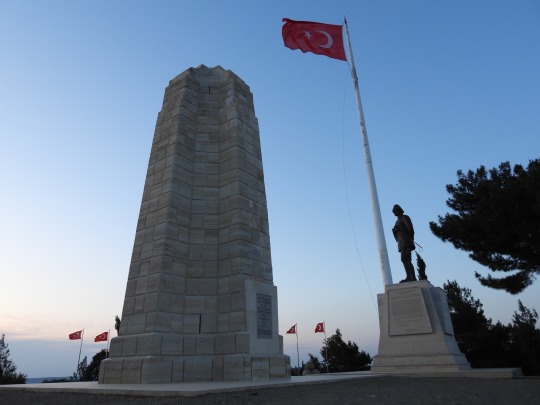
We returned to the hotel after that. Tomorrow, we are told, will be an easy day. We’ll bus to Troy, visit the Turkish town of Canakkale, and then do… something or another in the evening. It also means that I might be able to write a log that isn’t a massive wall of text - but we will have to see…
2 notes
·
View notes
Text
23 June 2023
The Sea of Blood
Gallipoli
23 June 2023
The Turkish flag is crimson red, with a crescent moon and a star emblazoned upon it. The meanings of the star and moon aren’t relevant here - it’s the choice of red. It represents the sea of blood that was shed for Turkish independence.
On V Beach, on the 25th of April 1915, the men of the Royal Dublin and Royal Munster Fusiliers (plus two companies of the Hampshires) spilled out of the deliberately beached collier River Clyde into a storm of Turkish rifle fire. The scale of death amongst the Irishmen (like their Lancastrian comrades over on W Beach) was such that the ocean was stained red.
Ireland, Great Britain and Turkey are all very different cultures, but in the flag of a nation and the sea of an Aegean shore, they all bleed the same.
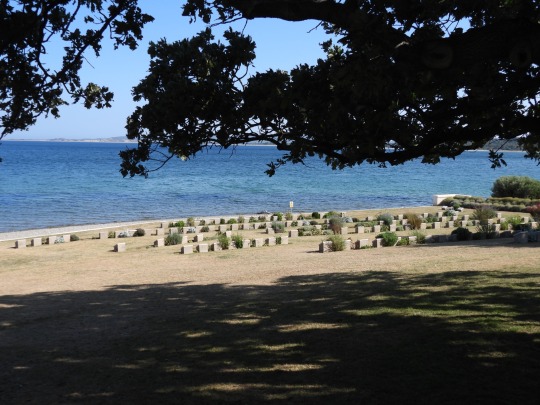
We started today at 8.30, catching the bus to the Beach Cemetary just beyond Ari Burnu, on the south end of Anzac Cove. Here we discussed the famed landing of 25 April - what we know of it, and what we know of it. The image of Anzac is a contested landing under withering fire, as reported in the war correspondant Ellis Ashmead-Bartlett’s dispatch. In fact, Ashmead-Bartlett was at sea on the 25th, and his report relied on second-hand information and some healthy artistic license - aside from at the Fisherman’s Hut to the north, the Anzac landing was largely uncontested. It was not until the ridges that the battle really began. Yet that contested landing is an integral part of Anzac lore, even after all the research that proves it mostly didn’t happen, and I think that’s because it’s such a heroic image - our version of Napoleon personally leading his men across the bridge at Arcole. Pre-dawn fighting also, of course, fits in with our dawn services - although I think the validity of the dawn service remains, as, contested or not, they did land at dawn.
We also stopped at Ari Burnu, where Ataturk’s (alleged) words are emblazoned upon a stone monument in front of the endless sapphire sea. We have a Turkish guide with us - that’s required by Turkish law, although she and my professor go back a long way - and she got me thinking a bit. Ataturk probably didn’t say those words, but as she said, does it really matter? Is the spirit more important than the historical authenticity? I don’t really have an answer to that. The historian in me says it absolutely does, but the citizen of the world in me says it doesn’t. (You may have heard the saying ‘inside me there are two wolves.’ Well, inside me there are two old white men.)

We went from there to Johnson’s Jolly on the Second Ridge, where we explored the old trench lines that have been rediscovered by battlefield archeology. It was here that I became the most recent casualty of the Gallipoli campaign, because I fell into one of the trenches. My only injury was a very slight wound on my arm, but I’ve got a sense of pride in being the last person (for maybe a day or two) ever to be wounded at Gallipoli. From Johnson’s Jolly (named after an artillery officer who would ‘jolly up’ the Turks with his battery’s fire - black humour was and is an intergral part of military life - we headed down Shrapnel Gully (again - there’s more than one path through it) to the 4th Battalion Parade Ground Cemetary. As the name suggests, most of the men buried here are of the 4th Battalion, largely made of New South Wales men, but there were a smattering of other men from the 1st Brigade, a few New Zealanders, and some men of the Royal Naval Division. We’ll talk about them at a later date, I promise.
We continued on after a brief interrogation of the Parade Ground, stopping to look over Monash Valley. Brigadier John Monash commanded the 4th Brigade, which consisted of men from all states. Monash was by all accounts a fairly mediocre brigadier, and at Gallipoli he’s most known for getting his brigade lost during the attack on Hill 971; he was eventually promoted, of course, and became a first-class corps commander in 1918. Looking over the terrain, I wonder if critics of Monash’s performance as a brigade commander are being too harsh - the distances at Gallipoli are tiny as the crow flies, but men, of course, do not fly. They have to navigate rough and unforgiving terrain, to climb and descend steep hills, often where no paths exist. It was inevitable that confusion would reign supreme.
Everything I learn of Gallipoli blackens my opinion of the entire concept of the campaign.

We ended our trek at Shrapnel Gully Cemetary, where we remained for a while to examine the graves there. By now the heat of the day was really setting in, and we returned to the hotel to wait it out. I ate noodles for lunch. I have no idea what kind, but I enjoyed them. Then I rested - I’m reading Gary Sheffield’s Short History of the First World War to reorient myself on the course of the war, and I quite like it.
At 5pm, we reassembled at the bus and headed down to Cape Helles. If one looks at a mapo, they can see that Gallipoli resembles a bare shoe, gingerly poking its toe into the Aegean. Helles is essentially the toe. This was the British and French sector - although Australian battalions did go to Helles, and British troops did fight at Anzac, so it was never quite so simple.

Our first stop was V Beach - one of five beaches attacked by the British in this sector. I think looking over V Beach today was the first time I experienced a really strong emotional connection on the tour - despite the modern boats and new buildings in Sedd el Bahr, the contours of the beach are almost exactly as they were in 1915. It looked almost like a colourised version of one of the pictures taken from almost our exact position after the landing. In my mind’s eye, I could picture the River Clyde - the Trojan Horse collier serving as a landing barge - beached in the shallow water, the scores of doomed men trying to clamber out, the few survivors huddling in the shallow shingle at the end of the small beach, and that blood red sea. I did not imagine the sound or the smell - I do not think such a thing could be imagined. I did feel a distinct lump in my throat, though, and a sense of disgust at the waste that happened here.
The British Memorial at Helles overlooks V - to the west, you can just about see W Beach (or Lancashire Landing), and if I had climbed the tower I’m certain I could have overlooked X and Y to the north, and S to the east. One of the great absurdities of Helles is that the landings at S and Y went off without a hitch, but they were starved of reinforcements as Generals Hamilton and Alymer Hunter-Weston dispatched their reserves to X, W and V. This is a cardinal military sin - you reinforce success, not failure. Yet in the grand scheme of things, it would have made little difference. Having more men at Y Beach (the British troops there called it ‘Why Beach,’ as they had no idea why they were there) wouldn’t have enabled the Allies to advance rapidly on the Dardanelles. Gallipoli does not smile upon rapidity.

We moved on to the Turkish Memorial. For legal reasons I can’t give my full opinions on this, but I can describe the structure. It’s almost like a flattened arch (and indeed, was meant to be a modernised Roman arch), the Turkish flag emblazoned on the roof. Ataturk had once said that a memorial as high as forty meters would not be enough to properly commemorate the dead of Gallipoli - so fittingly, this memorial is forty-one meters tall. The Turkish defenders are listed on surrogate graves around it, their names etched on red glass. It’s an evocative image, especially in the evening sunlight. There’s also at least three statues of Ataturk on the precint and I probably missed some, which gives you a very good idea of just how central he is to the Turkish story of Gallipoli.
We also noted here that of all the nationalities that fought at Gallipoli, only one is not commemorated here. I’m actually not going to tell you what that is - I want you to guess.
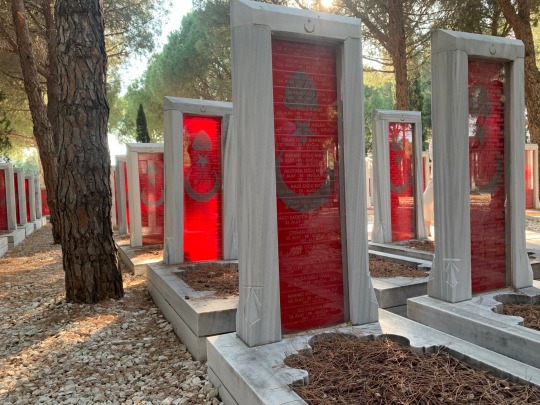
We continued to the French memorial - or perhaps French-led memorial is a better term. The French names are attached to catholic crosses very poorly disguised as the fleur-de-lys to provide plausible deniability to the Turks, who generally don’t like big, visible crosses on their land. I say French-led because a great many of these men are actually Senegalese - men recruited from the French colonial empire in Africa. Many of these men were appallingly treated and wasted on the battlefield - to say nothing of what became of them when captured by the Germans. Their rewards were anonymous graves, with no effort to mark their religious beliefs, and almost certainly no benefits from the state for the families they left behind. Even the Indians in British service got the basic decency of having their faith marked on their gravestones - no such luck for the Senegalese.
We ended the day near Krithia, the scene of three useless slogging matches fought in April, May and June to capture the heights at Achi Baba. This land is much flatter and more open than Anzac, but there are lots of ridges and rises that aren’t immediately obvious. The Ottoman forces, like Wellington before them, clung to these positions, and the British, French and Anzacs took heavy casualties in their fruitless attempts to dislodge them. Even the Third Battle of Krithia, which was deliberately smaller in scale and in which one corps actually managed to take their objective, came undone when Hunter-Weston insisted on spending his reserves on failing attacks in other sectors, allowing the Turks to regroup and retake their positions.
In case you’re feeling too sorry for old Hunter-Bunter by the way, he once referred to heavy casualties suffered by one of his battalions as ‘bloodying the pups.’ He was, and I hope you will excuse my vernacular, an absolute fuckwit.
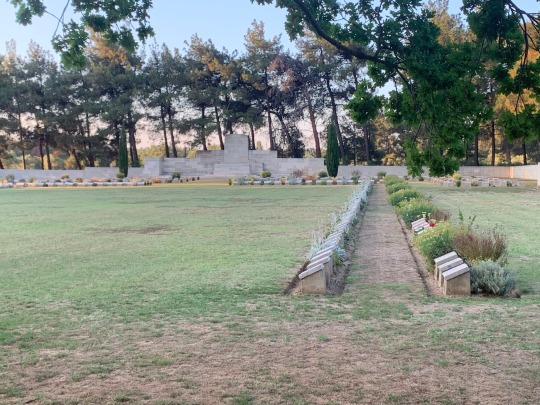
The Redoubt Cemetary is a little way south of that unassailable town of Krithia, and is a testament to stubborn endurance in the face of all sanity. In particular there are a lot of men who died on that last June attack, the ‘limited’ offensive - Manchesters, Royal Lancastrian Fusiliers, Marines and sailors of the RND, Leicesters and Cameronians and Sikhs and Royal Scots. Amongst these proud and distinguished old regiments are men from Australian and New Zealand battalions, killed in the attempt to support the British 29th Division at the Second Battle of Krithia. Accounts by their British allies record the bravery of these men under fire, painting the very image of Anzac - except, of course, their attack had been planned in about thirty minutes, and they never came anywhere close to their objectives. Men were mown down like wheat before a scythe - my professor’s words. Some were burned alive as bullets set off their ammunition, while others were disemboweled by machine gun fire.
There’s a very clean painting by Charles Wheeler in the AWM depicting the moment the Second Brigade advances, their Brigadier, Jim McCay, fearlessly urging them on while exposing himself to fire. It sanitises the slaughter that follows. It also doesn’t tell us that McCay, that glorious Victorian image of military heroism, was detested by his men for sending them into that battle. (McCay will be back, unfortunately - he’s proof that the ‘donkeys’ were not just British.)

We left the British sector at around 8.30pm, and drove alongside a beautiful red sunset back to the hotel. At this point, I’d be remiss not to mention Maddi, one of our student helpers. I tend to mention the really dramatic stuff and leave out all the little administrative things that tend to go wrong. When these things happen - like some idiot falling into a trench, for example - she’s been consistently on the case. She’s one of only two helpers responsible for handling twenty-eight university students, which is like herding cats, except the cats tend to be more organised. She has been doing an absolutely superhuman job at it, and I can say with confidence that none of this would be possible without her.
Well, that concludes Day Two in Gallipoli. Tomorrow, we’ll visit two of the most evocative sites in the memory of Gallipoli - Lone Pine in the morning, and in the evening, the Nek.
2 notes
·
View notes
Text
22 July 2023
Journey to the Front
Gallipoli
22 June 2023
I won’t lie to you; today was incredibly hard. It’s one thing to travel between countries, quite another to do so when neurodiverse, and another indeed to do so alone for the first time. If I’m not particularly erudite today, please bear with me. I am both physically and mentally exhausted.
I awoke at 2.15am and was on the bus by 3.15 to get to Heathrow. We flew out on a Turkish Airlines A220 and landed somewhat bumpily at Istanbul just after 12.30 local time, We then met our tour bus – which oddly enough has better internet then our hotel – and drove to Gallipoli, stopping at a rest stop by the Sea of Mamara for a discussion of the submarine AE2 and, more importantly, a cheese toastie.
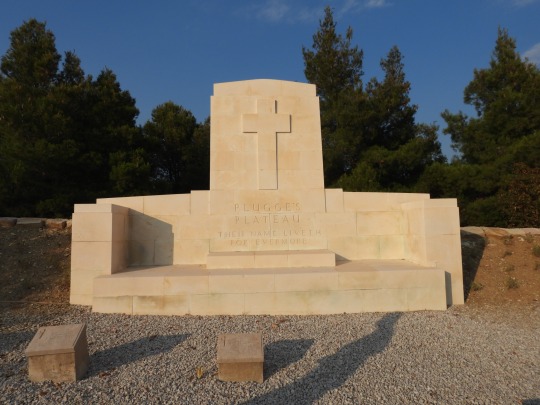
We arrived at Gallipoli at roughly 6pm – due to our late arrival, it was decided that we’d make the most of the remaining light and ascend Plugge’s Plateau before checking into the hotel.
Plugge’s Plateau, named for a New Zealand officer, is a position on the ‘first ridge’ – there are three key ridges inland from Anzac Cove. To get to the top requires a short but arduous trek through Shrapnel Gully and up the cliffs that overlook Anzac Cove, the landing place of the Australia and New Zealand Army Corps. My first impression from climbing the ridge was to think back to my first thought upon viewing the battlefield at Culloden years ago – that this was an astoundingly poor choice for a battlefield. To get off the beach, one must ascend this steep ridge, then descend it into the gullies and valleys beyond and climb the second ridge beyond. Once you’ve taken this position, you still need to capture the third ridge, a task that eluded the Allies (for British and Indian troops also fought here) throughout the campaign. From our final position, just a little inland from Plugge’s, we could see ‘Quinn’s Post,’ the ‘Sphinx’ and Lone Pine – I never really appreciated just how close to each other they were, yet just how difficult it would have been to travel between these positions and the beach – and between each other, for that matter.
The path also has a very good view of Anzac Cove facing northwards – one can see as far as Suvla Bay and the salt lake there. I must admit to a little pride in noticing Suvla before I was explicitly told what it was – all that map reading wasn’t in vain, it seems. I think it’s still in the air as to whether or not we shall visit Suvla, but I certainly hope we do – it is one of the most interesting and misunderstood aspects of the campaign.

As a rare example of a mostly intact battlefield (the only others I can think of off the top of my head are Culloden and possibly Waterloo), we will be remaining in Gallipoli for five nights for a fairly in-depth tour. But if I’m going to have the energy to take part in said tours, I had better sleep, so I shall see you all for some more in-depth discussion tomorrow.
2 notes
·
View notes
Text
First of all, my apologies for going quiet. I’ve been dealing with limited time and spotty internet, but now I’m in a place with free time and stable internet, I’m going to start uploading the backlog.
0 notes
Text
21 June 2023
You’re In The Army Now
London
21 June 2023
It was an early start today - I was out the door just after 7.30, catching the Victoria Line to Oxford Circus and the Bakerloo to Paddington. It was already very busy, but there was a laurel at the end of my journey to make braving rush hour a little bearable. It look me a little questioning of staff before I knew whether or not my journey was in vain - it wasn’t - and then I proceeded to sit on Platform One for an hour because I’d massively overestimated how early the train would enter the station. And what locomotive, pray tell, would I go to all this trouble for?
If you know your trains, you could probably make an educated guess.
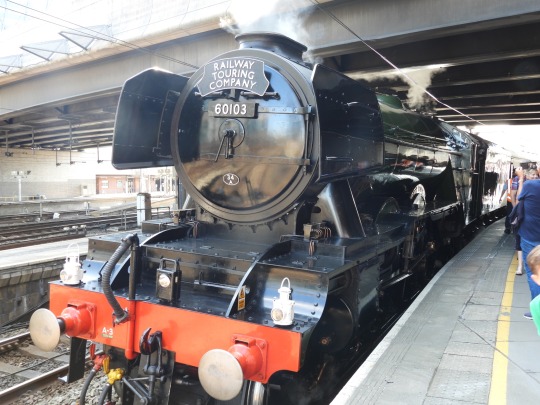
Built a century ago this year, No. 4472 - ahem, 60103 Flying Scotsman needs absolutely no introduction. Today she is the Kardashian of locomotives - she is famous for being famous. Unlike the Kardashians, that fame is well earned - namesake of the famed Flying Scotsman express, first non-stop run from London to Edinburgh in 1928, first (sort of) authenticated 100mph by a steam locomotive in 1934, one of the first privately preserved steam locomotives. She toured the United States (even though we don’t like to talk about how that one nearly ended) and Australia, making the longest non-stop run by a steam locomotive ever between Parkes and Broken Hill. To her detractors, she’s the ‘flying moneypit,’ bankrupting every owner since 1963. To her fans, she’s the most famous steam locomotive in the world, Sir Nigel Gresley’s masterpiece. And at long, long last, I have seen her in steam.
Basically, do you know how monarchists get really excited about seeing the King? This is my version of that.
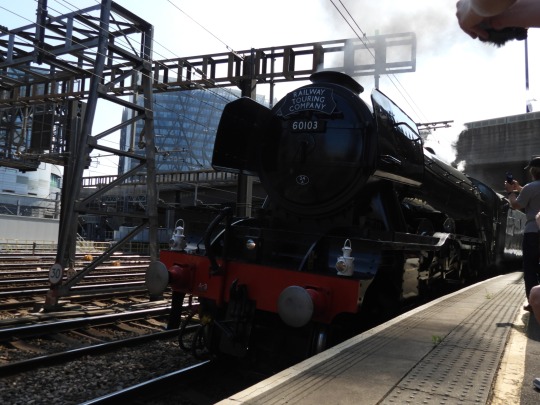
After her departure at 9.40, I headed on the Circle Line to Sloane Square, walking through Chelsea and past the famed hospital there to the National Army Museum. The NAM is basically the cooler, hipper IWM, in my opinion. It perhaps benefits from a narrow subject matter; specifically Britain, and specifically the British Army. Without becoming too complicated, it does a much better job at contextualising its exhibits than the IWM, without shying away from the controversies and horrors of war. Do you think, for example, that the Australian War Memorial would stock a book about the massacre of Surafend, in the way the NAM stocks one on the British organised mass slaughter of Amritsar?
When I talk about museums, as you probably know by now, I like to mention an exhibit that struck me, and the exhibit in question at the NAM was more recent than you might expect. While I could discuss the saw that amputated the Earl of Uxbridge’s leg again - the fact that it still exists makes me very happy - I’ll instead mention a ruined L85 rifle from the Middle East, which was recovered from a vehicle destroyed by an IED - none of the passengers survived. Jay Winter has said that if one shows a weapon in a museum, they ought to show what it does. Here, in this ruined weapon, we see both at once. We don’t need to see the blood and bones of the soldiers; from this broken rifle, we can fill in the gaps as to the horrific power of explosives ourselves.
Also, the NAM cafe does a mean scrambled eggs.

After the Army Museum, I headed back to the tube and caught the Circle Line again to St. James’ Park, where I walked to the Guards Museum. This is a small museum that people don’t really know about, and that surprises me as it’s literally right across the road from Buckingham Palace - it’s in Wellington Barracks, where the guards march from during the Changing of the Guard.
The Guards Museum is a very old-school and classic museum; a British Army regimental museum in the same old style that I love so very, very much. The museum is both wide in scope and intimate in subject matter - this isn’t the story of the army or the wars it fought, but the part played by the five regiments of the Foot Guards - the Grenadiers, the Coldstream, the Scots Guard, the Irish Guard and the Welsh Guard. For the majority of the British Army’s history, there were only the first three - oddly, the ‘1st’ (Grenadier) Foot Guards are actually the youngest, but as they were Charles II’s personal guard, they got to be senior after the Restoration in 1660.

There were a lot of very interesting things in this museum, but I’m going to highlight something very boring instead. There’s a shako worn by a soldier of the Coldstream Guards in the late 1820s - it’s called a bell-top shako. Guards shakos from this period are very rare, because they were introduced in 1829 and dropped in 1831, when all of the Guards regiments adopted the bearskin cap of the Grenadiers. In fact, this shako was so rare that I didn’t actually know it existed - I’d assumed that the bearskins were adopted soon after Waterloo, but it seems the Coldstream and Scots Guards kept the shakoes of the regular infantry for just a little bit longer. This is a completely, utterly useless factoid, but I find it absolutely fascinating.
Across from the Guards Museum is the Guards Chapel, and to the uninitiated it looks strangely modern. Surely regiments as old as the Guards ought to have a similarly old chapel, right? Well, they did - until the morning of 18th June 1944, when it suffered a direct hit from a German V-1 flying bomb in the middle of a morning service. 121 were killed, and over 140 injured. The new chapel is not only a memorial to the men of the Household Division (the Foot Guards and the Household Cavalry), but to those killed in the bombing. I was initially the only visitor, and by the time I left only a small group of Americans - who I will say were very respectful - had joined me there. Dozens of regimental colours from throughout the Guards histories hang from the walls. I almost felt like an intruder in another family’s mausoleum.
I’m not religious, but for some reason I was moved to light a candle.

I walked from there, back past Buckingham Palace and down Lower Grovesnor Place, to a small memorial on the side of an intersection near Victoria. This is a curious little monument - it’s explicitly a memorial to the Great War, yet the Tommy on top is joined by a pair of riflemen from the Napoleonic and Crimean Wars respectively. This is the memorial to the Rifle Brigade, the progeny of the famed 95th Rifles of Wellington’s time (although a number of Rifle Brigade battalions could trace their heritage to the 60th Rifles as well.) After the Second World War, it was adapted to commemorate the riflemen lost in that conflict.

I visit a lot of memorials because I think they are interesting, or because I simply find them in the wild. I hunted down this one because it was important to me personally. This isn’t because I think the 95th were cool or because I watch a lot of Sharpe, or because green is my favourite colour and riflemen wore green uniforms. My nan had two uncles, one who fought in the First World War and one who fought in the Second. Both were riflemen - the first of the ‘Hackney Rifles’ and the second of the 7th Rifle Brigade. The first was wounded at Third Ypres, although I’m not certain how severely. The second still lies to this day in Florence, lost in the attacks on the Gothic Line in September 1944. It’s silly, and probably vulgar, but I’ve always seen the Rifle Brigade as ‘ours.’ I probably confused a lot of London commuters by pointing at a random monument in the middle of the city, repeating over again - ‘that’s us. That’s us.’
Yet it is us. The memory agents, the people who lived through the First World War, are all dead. The people who lived through the Second will still follow. It is now up to us to interpret their memory, their experiences, their histories and their stories. We have a responsibility to them.
Like it or not, this is us.
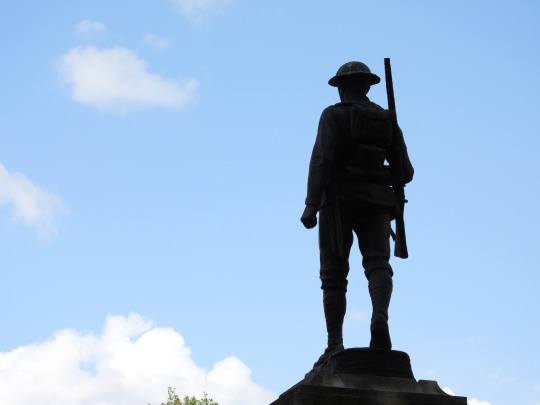
I then wrecked this profound emotional moment by having a big fanboy moment over a Routemaster bus, and then I walked back to the hotel. After a brief rest, I reunited with my mum and stepdad, who had been very kindly invited by my professor to join the group at the garden party of the Britain-Australia Society at the Royal Over-Seas League’s London HQ. It was all very sophisticated, with a lot of the great and good - and Joe Hockey - present, but I think it just didn’t quite gel with me. We stayed for a socially acceptable amount of time, then went back to Victoria Station and grabbed some McDonalds before parting.
We will reunite in Paris, but there’s a long road ahead to get there…
#flying scotsman#national army museum#guards museum#rifle brigade#first world war#second world war#napoleonic wars#crimean war
18 notes
·
View notes